



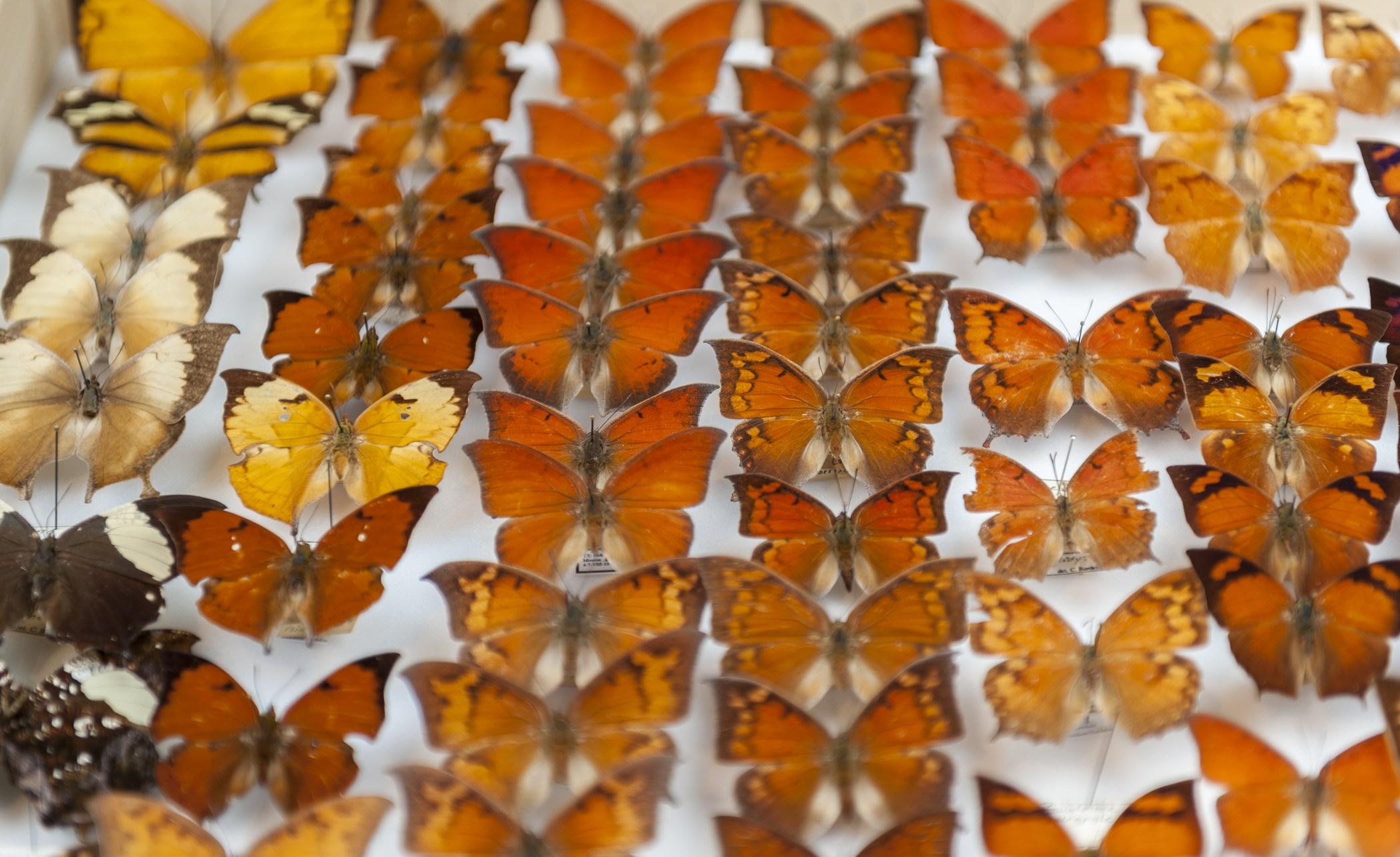


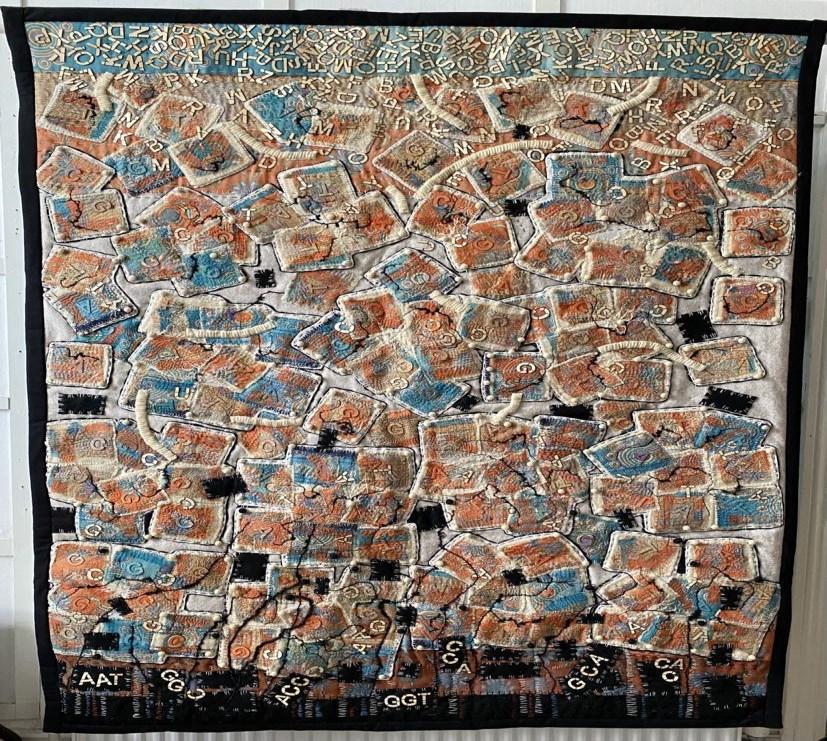
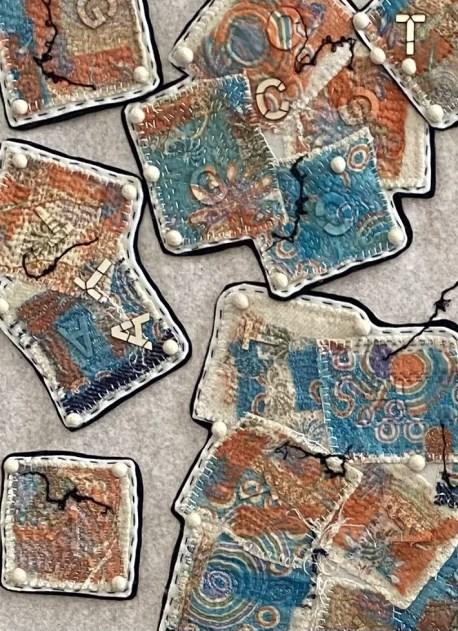
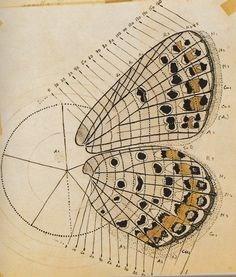
1 The Stitchbook Issue No 9 www.thestitchbookcollective.com
DON’T PANIC or feel stressed! Take a deep breath and just get started ... see where it takes you!

The group is here to support and encourage everyone. We have members with enormously varying levels of expertise to share knowledge and ideas generously, and BE KIND. The archive of 12 techniques is permanently available to you whenever you want to try something new, and the monthly workshops and the magazines are there as inspiration and encouragement.
www.thestitchbookcollective.com
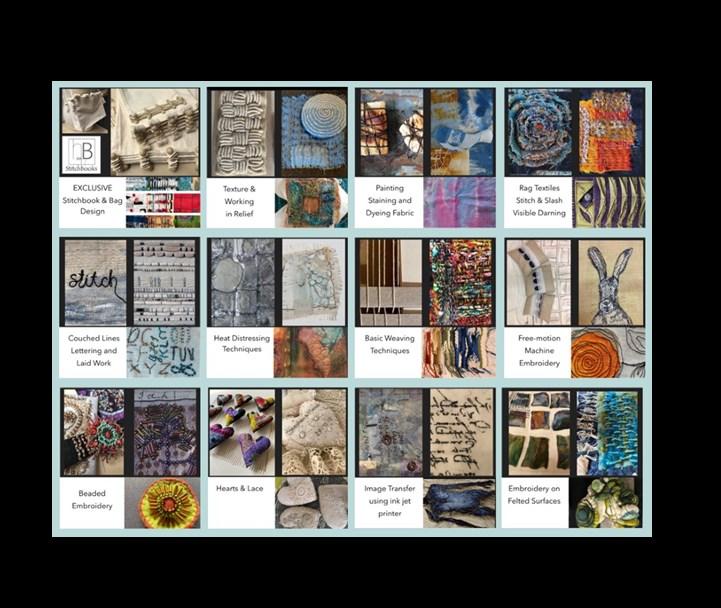

2 ISSUE No 9 Butterflies CONTENTS Page WORKSHOP 3 NEW Project LAUNCH 11 Food for Thought 13 Project Updates Hearts & MIND 14 DNA spiral 15 Back copies of Magazine 16 World Mental Health Day 18 MEMBERS PAGES 19
We will begin this month with the universally recognizable image of a butterfly.
I would like us to look at this familiar (some may say trite) image, and use it to explore the process of ‘finding your own connections’ to any given subject . I will show you some very basic research techniques and my own version of ’mind-mapping’ in the hope that it may offer a solution to any ‘creative block’ which , let’s face it, we all feel at some point .. Let your mind be free like a butterfly!

The Butterfly Effect
Would you like to get involved in the decision-making and designprocess for a NEW quilt for Festival of Quilts 2024
See page 11 for more information.
You could WIN a copy of ‘The Art of Embroidered Butterflies’ by Jane E Hall
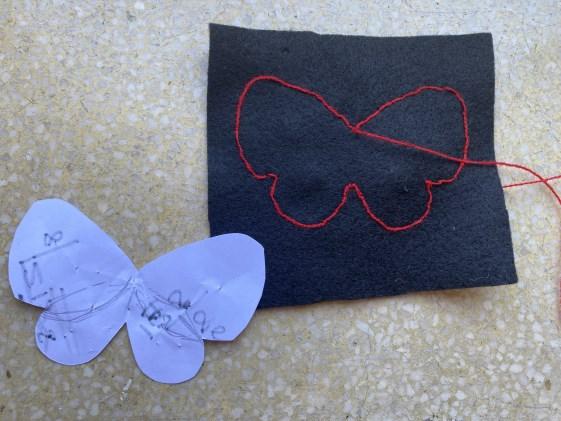



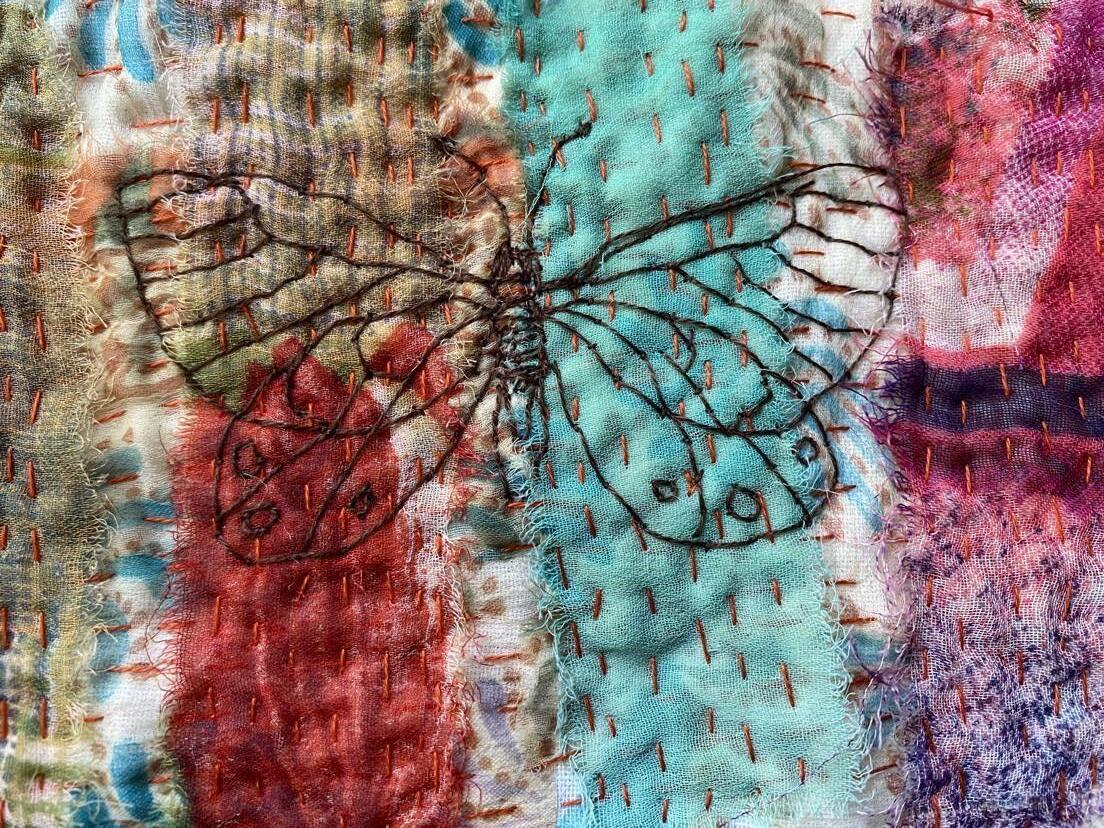

3 WORKSHOPS BUTTERFLIES WORKSHOP www.thestitchbookcollective.com presented by Helen Birmingham
No
Issue
9: first published September2023
WORKSHOP
INTRODUCTION
I believe that The Stitchbook Collective offers something for everyone, whatever stage of the journey you have reached - beginner or expert stitcher - but I do know, that for all of us, one of the most intimidating things to face is the blank page
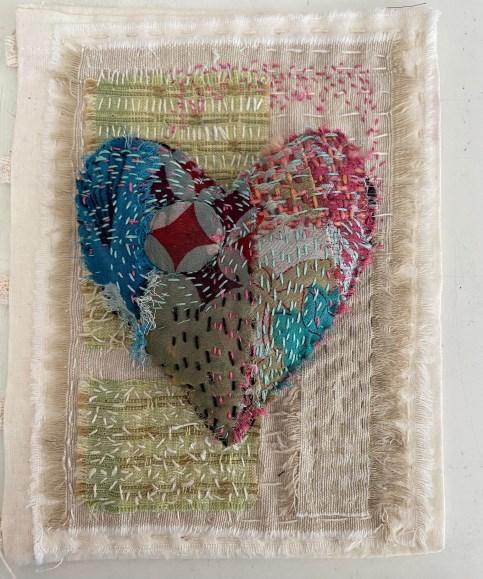

In terms of purely ’meditative stitching’ the blank page can be our friend .. it allows us complete freedom, purely and simply, to stitch, and for some this will always be enoughto create something as perfect and complete as stitches on a piece of fabric will become a mediative practice in itself.

However, I do think that we often feel a legitimate ’, ‘to communicate to find connections with etc etc. This workshop aims to guide you through some simple steps to find that illusive spark .. the shining gem of inspiration that you may
HEARTS & BUTTERFLIES
It may surprise you to know that I used to feel a strong sense of dislike for both the heart and the butterfly motif. I felt that they were overused, unimaginative and too simplified to be of any real interest to me as an artist … but I was missing a really important point: recognisable symbols are fundamental to our ability to communicate effectively with one another. They become a sort of universal shorthand. So much ’backstory’ is already held within them it becomes very easy to use them to either support or subvert an idea. For example, our current fundraiser uses the phrase Hearts & MIND to great effect.
In this workshop I am going to use the BUTTERFLY motif as my starting point. It will instantly banish the ‘blank page’ and will give me some useful stopping off points as ’individual teaching moments’. You can see my thought processes on page 6.
I hope you find it encouraging .. please don’t feel limited or restricted by my thoughts. Let your mind go free and try to develop your own creative mind-map.
The blank page is familiar to us all, and it can either feel like the ultimate freedom, or a step too far. I think that it mostly depends on our current state of mind. In this workshop I want to share my creative thought-processes with you, not because I think that my thoughts are any more important or relevant than your own, but I hope that by appreciating that everyone struggles with creativity and self-doubt at some time, on some level, it may really help you to trust your own process, take away some of your ’performance anxiety’ and let you enjoy the relationship you are beginning to have with your Stitchbook.
Everyone’s result will be different. Above are some of the samples which I created after looking at the topic of BUTTERFLIES. PLEASE SHARE your work! Don’t be intimidated by others. If your process ended with ARGHHHH, let me know that too! If you like, we can try to work through it together! email: thestitchbook@aol.com

4
Example of Mind-Mapping
Pinterest
Google
Transformation
Change
Growth
Challenging & rewarding
Caterpillar
Chrysalis
Rebirth
PHOTOS & DRAWINGS
LIFE CYCLE

Poetry Prose Stories
Identify, record, monitor
Environment
Pollution
CONSERVATION
Techniques
History Stitches
QUOTES or SAYINGS

Lepidoptery
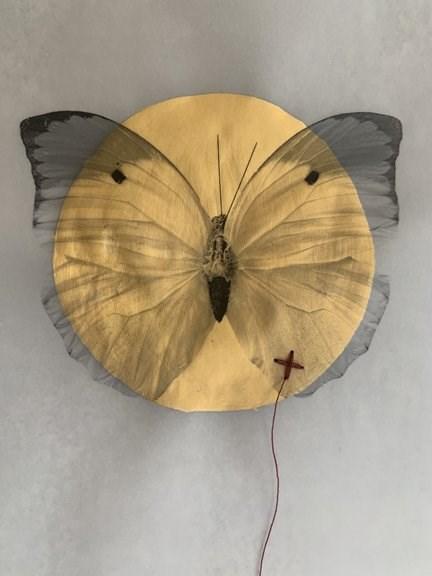
Peppered Moth
Evolution
Differences
Ceramics, Jewellery, Paintings, Sculpture
ARTIFACTS/ HISTORICAL REF ANATOMY
Wings Thorax Abdomen
JEWELS COLOURS
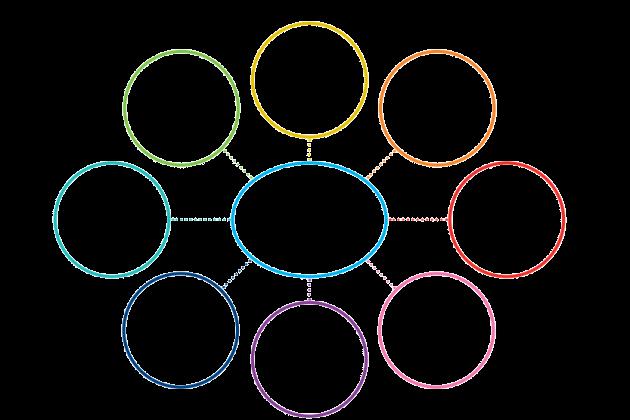
Head
Antennae

6 Legs
‘Stitching enables me to find, and listen to, my own authentic voice.’
‘The Stitichbook Collective: A Shared Vision’ Helen Birmingham

CRAFT & EMBROIDERY
Goldwork
Couching
Long & Short
Iridescence
Reflection
Sunlight
You should have received a copy of this with your first magazine. If you didn’t, please let me know.
email: thestitchbook@aol.com
5
Image by Catherine Just
MY THOUGHT PROCESSES
I have always been fascinated by botanical illustrations. My father had a butterfly collection which he kept in a rather tall, austere Victorian cabinet of glass covereddrawers, and I somehow accepted that the rather macabre stabbing of the samples with entomology pins was a necessity rather than a cruelty, I remember he had collections of cigarette cards and silks with butterflies on them too. I used to love going to Tring Museum and standing on tip-toe to open the lidded cabinets and gaze in wonder at the iridescence of the wings.
Quite a lot of my ‘Darwin-inspired’ artwork is based on Victorian research and collections and many pieces are fixed into frames using entomology pins.
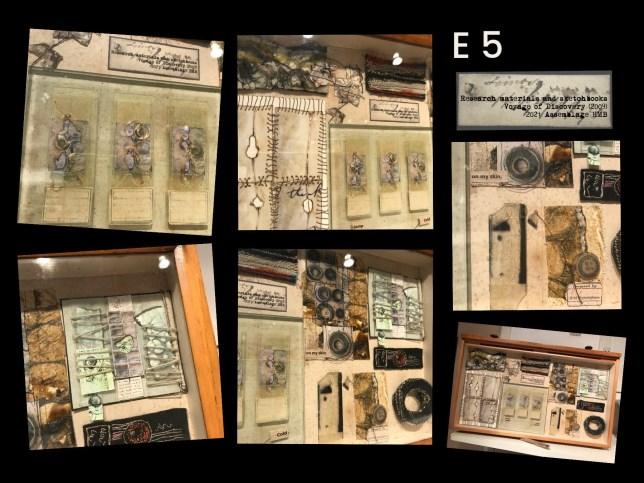
1) The importance of anatomy and the use of a template to
a) stitch a ‘line drawing’ onto a pre-stitched background, or
b) create a needle felted background as a contrast to areas of embroidery
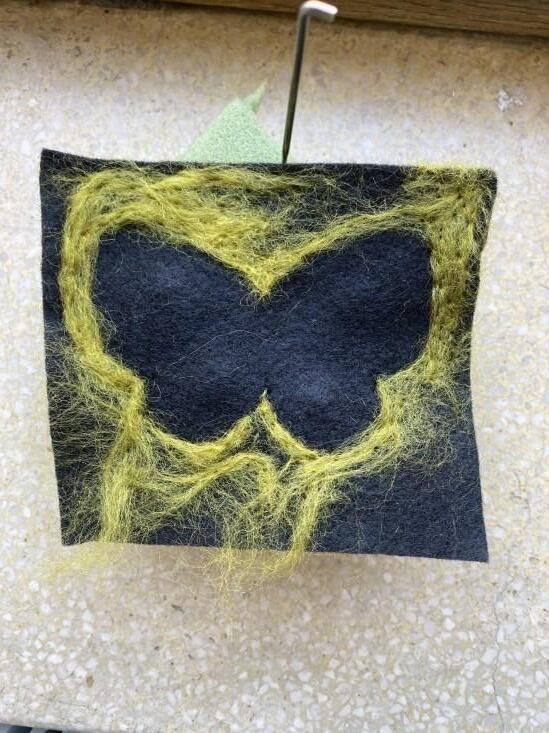
2) Camouflage or attraction and the evolutionary effects of pollution on the colour of Peppered Moths.


3) Looking at different embroidery stitches used to represent the texture and colour of butterfly wings, and how this led me to ...


So, having said that, you won’t be surprised to hear that I come at the subject of butterflies from a very direct, hands on approach and I am particularly interested in their anatomy, colour and flight.
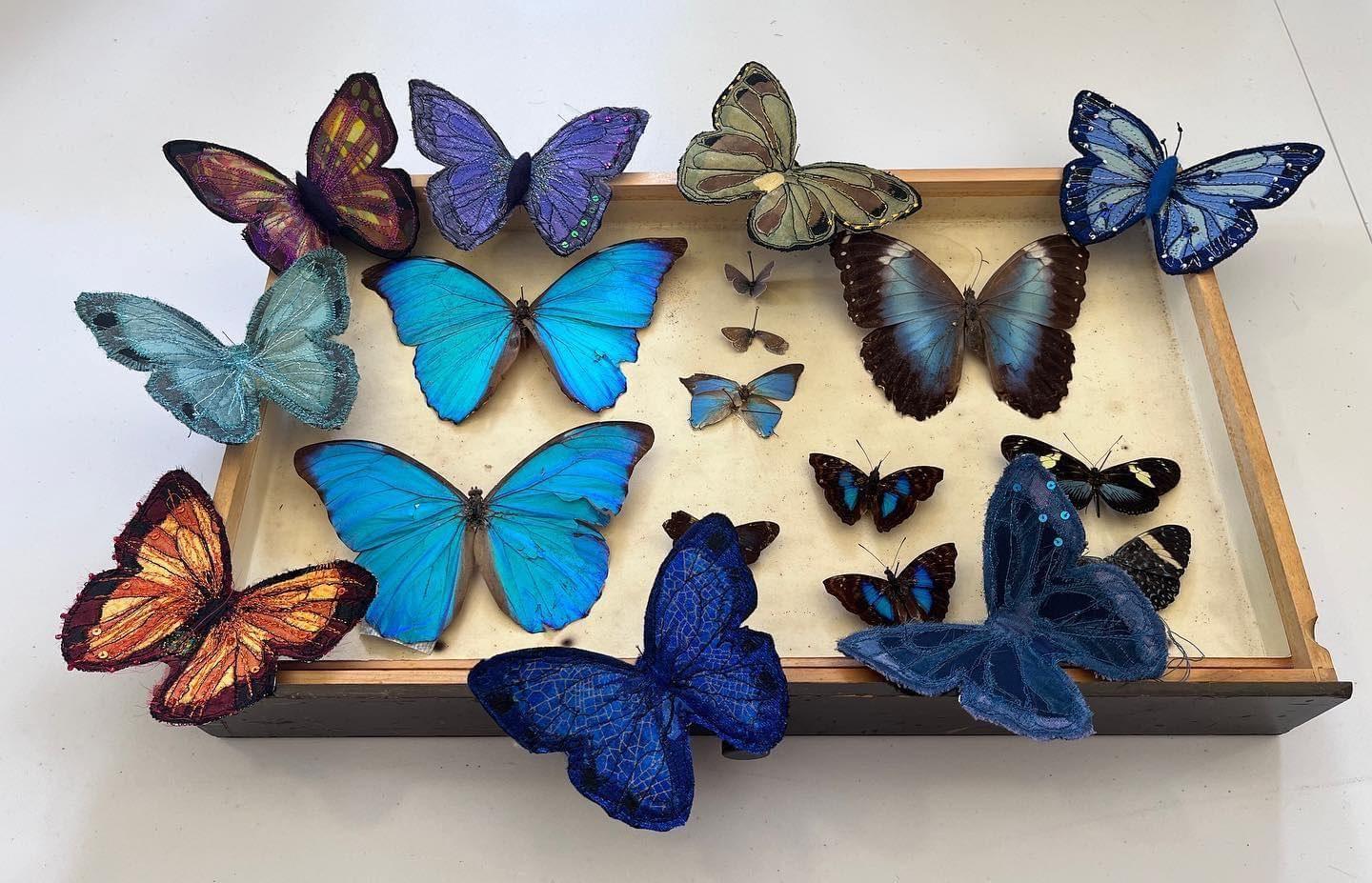

My research led me down some blind alleys, as I think may always be the case, but in terms of inspiration for stitching, it was a goldmine. Remember, It doesn’t matter which direction you take not everything will work out, but if you relax and enjoy the journey you’ll learn from it anyway
I have written instructions for 4 different examples of work which were inspired by this research. Please feel free to work all, some or none of these examples for your own Stitchbook. Once you have made your own ‘mind map’ you may well find that you have plenty of inspiration of your own!
4) my first look at goldwork and Opus Anglicanum embroidery and setting myself a future personal goal.
AND DON’T FORGET:
Would you like to get involved in the decision-making and design-process for a NEW quilt for Festival of Quilts 2024
See page 11 for more information and FULL INSTRUCTIONS on how to make these origami fabric butterflies



6
WORKSHOP SAMPLES
RESEARCH EXAMPLE 1
Importance of ANATOMY
If you are wanting to make a convincing image it is important that you understand how an object or an animal is actually constructed.
• A butterfly’s body is always made up of 3 parts: the head, the thorax and the abdomen.
• There are 4 wings, but in flight the forewing and hindwing effectively join together and act as one wing on either side of the body.
• The wings are ALWAYS attached to the thorax, as are the 6 legs.
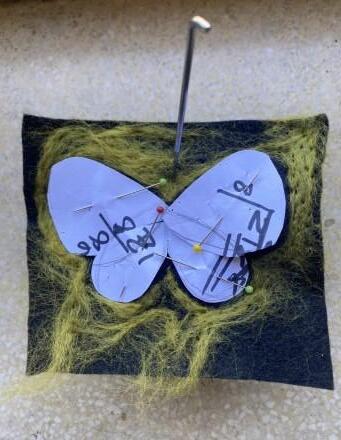
• When a butterfly is at rest it folds its wings upwards so that the hindwing is covering the forewing and only the underside of the hindwing is visible. The underside of the wing is not brightly coloured.

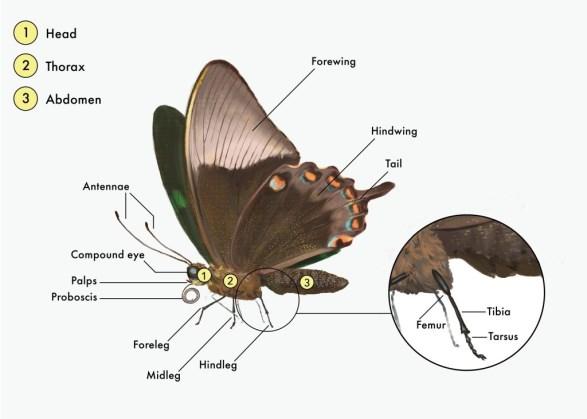
MAKING A TE,MPLATE
A butterfly has perfect symmetry. An easy way to make a template of a butterfly is to start by folding a piece of paper in half and draw half a heart onto it. (Line in red). The head, thorax and abdomen should be placed within the heart shape. Remember to make sure that BOTH wings are attached to the thorax. They should overlap, and fit into the shape of the heart. (You can obviously adjust the shape of the wings). Cut around your butterfly and unfold the paper. Pin the template to your fabric and draw or stitch around it. You can cut the wings out separately to make sure that the overlapping wing is placed correctly.


If you trace and cut this template from card it is very useful for all sorts of tracing, stencilling or masking.
A very simple, but effective, use of a template is to pin it onto a felt backing and then needlefelt around it. When you remove the template you are left with a wonderful negative space which you can then stitch into.

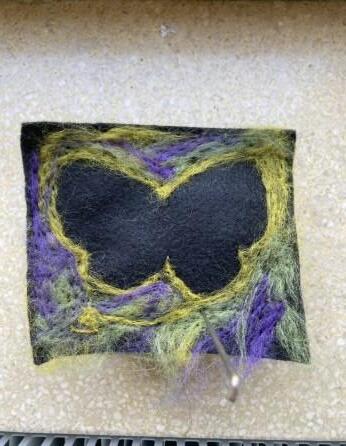



What about transferring your stencil onto interfacing and painting or drawing a design onto it, before stitching and embellishing it?

7
RESEARCH EXAMPLE 2
The story of the Peppered Moth
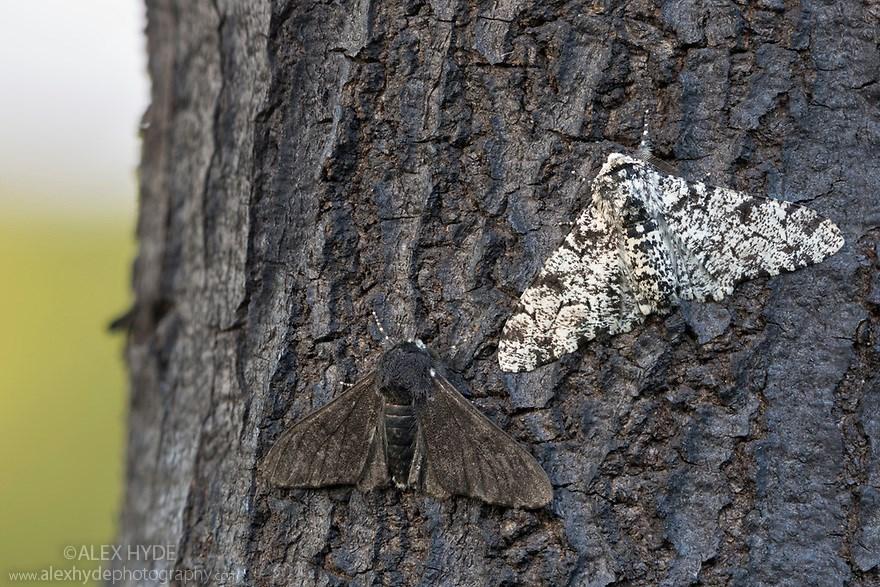
• In Manchester, before 1848 the peppered moth existed mainly as a pale version.
• In 1848 a dark version of the peppered moth was first noticed. The dark version was a chance genetic mutation.
• By 1898 this dark version outnumbered the lightcoloured version by 99 to 1.
Why do you think this was?
The explanation is that dark moths were highly visible to predators when resting on lichen-covered trees during the day. However, with the advent of air pollution during the Industrial Revolution, coal soot covered the trees and killed the light-coloured lichens. This meant that the dark moths on the trees were now less conspicuous than the previously light moth, leading to increased predation of light moths and reduced predation of dark moths.

Evolution in action! Below is my interpretation of this phenomenon, stitched with split stitch and mounted onto a slow stitched background
• The colours of butterfly and moth wings may serve several purposes. Colours are often used in courtship, so that male and female butterflies recognize each other as the correct species.
• Bright colours may also serve to warn birds or other predators that a particular butterfly is badtasting.

• Other butterflies and moths, although perfectly edible, may have colours that "mimic" the badtasting species and thereby gain protection for themselves.
• Finally, certain colour patterns may help the butterfly or moth blend into its background and be protected from birds or other would-be predators .
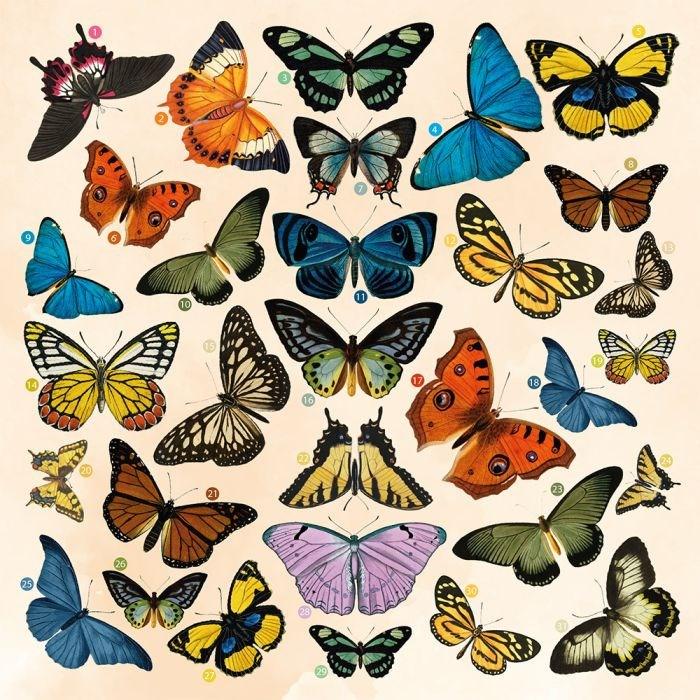
8
RESEARCH EXAMPLE 3 Formal Embroidery
I found this amazing book. My own embroidery skills leave an awful lot to be desired, and I was drawn to Jane Hall’s work like a magnet. The book isn’t an ‘instruction manual’, rather it is showcasing her exquisite skill with a needle and thread.

Live butterfly collection is now rightly frowned upon , but what if you could sew your own collection?


PLEASE share images of any embroidered butterflies you make!


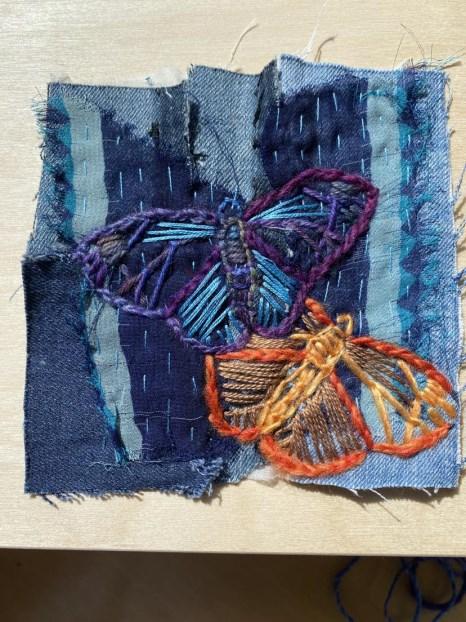
Can you believe that these are life size and hand stitched?
I’m sharing these images so you can see that I did give traditional embroidery a go, but I very quickly got fed up with my inability to do anything even vaguely ‘neat’. I’m going to blame it on arthritic knuckles, but actually I am totally in awe of the patience and finesse that goes into fine embroidery. But it’s a timely reminder that not everything will suit everybody!
The one thing that doing these samples did teach me is that I LOVE Couching and Split Stitch and that you can do it with pretty thick wools and yarns and big old tapestry needles! Take a look on the RSN stitch bank for instructions on how to do these stitches properly!


AND, I found a new fascination with Goldwork and Opus Anglicanum stitching!

9
RESEARCH EXAMPLE 4 Opus anglicanum
The phrase 'opus anglicanum' (Latin for 'English work') was first used in the 13th century to describe the highlyprized and luxurious embroideries made in England of silk and precious metal thread, teeming with elaborate imagery. These embroideries were characterised by technically difficult stitches such as underside split stitch
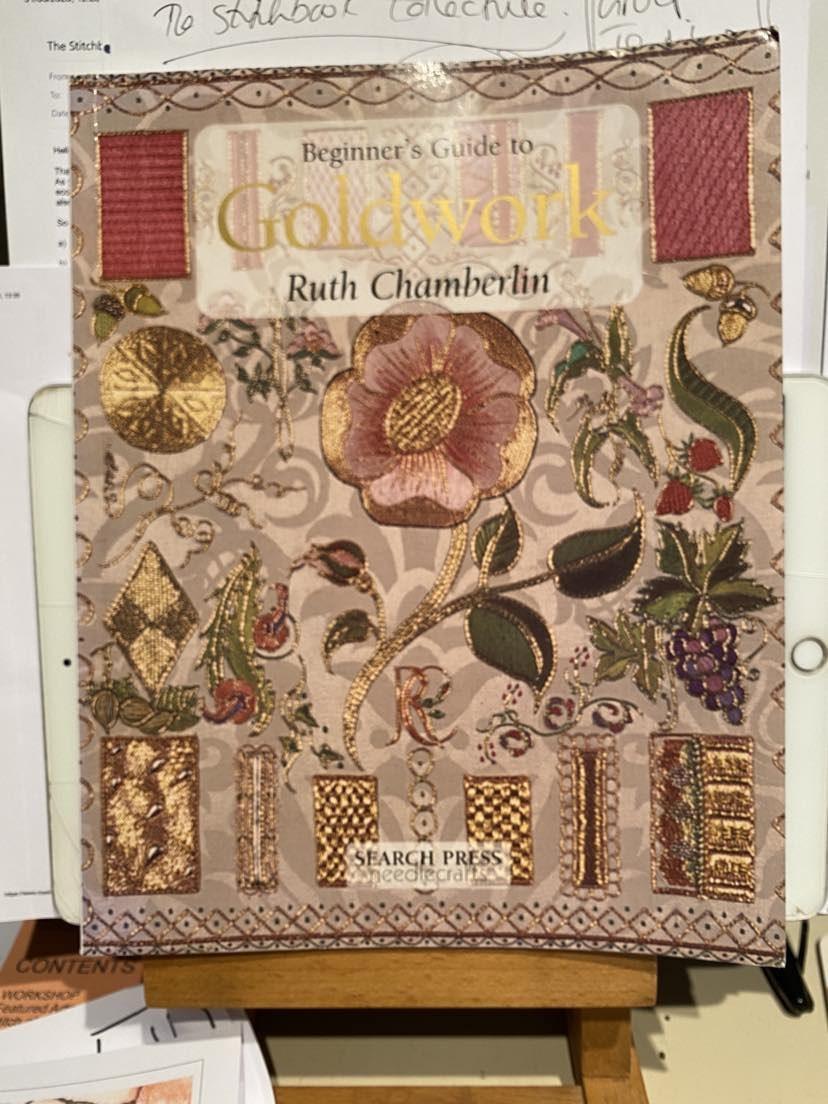


(This really is the Bayeux Tapestry with knobs on!)
Having come from a fine art printmaking background and moved into textiles rather by default, I have never been formally introduced to traditional embroidery skills , so all of this is excitingly new to me. These are 2 books which were recommended to me and I am finding so much of interest in them. Although the ecclesiastical and traditional nature of the designs is not to my taste, the techniques and effects which are shown are truly inspirational.

I am finding that the marks I can make are reminiscent of microscopic tissue samples, and I can see an elaborate and intense piece of work developing from this newfound information.
I hope that this workshop will have shown you the benefits of RESEARCH, and given enough examples and suggestions for you to create your own MIND-MAP generated from the starting point of BUTTERFLIES. My intention with this workshop is to encourage you to ‘think outside the box’ when it comes to finding inspiration for your Sttichbook. Be FREE LIKE A BUTTERFLY ...
REMINDER:
STITCHBOOKS are about self-expression. There is no right or wrong. You aren’t being marked. It isn’t a competition or a race, and a good teacher can only show you where to look, not what to see!
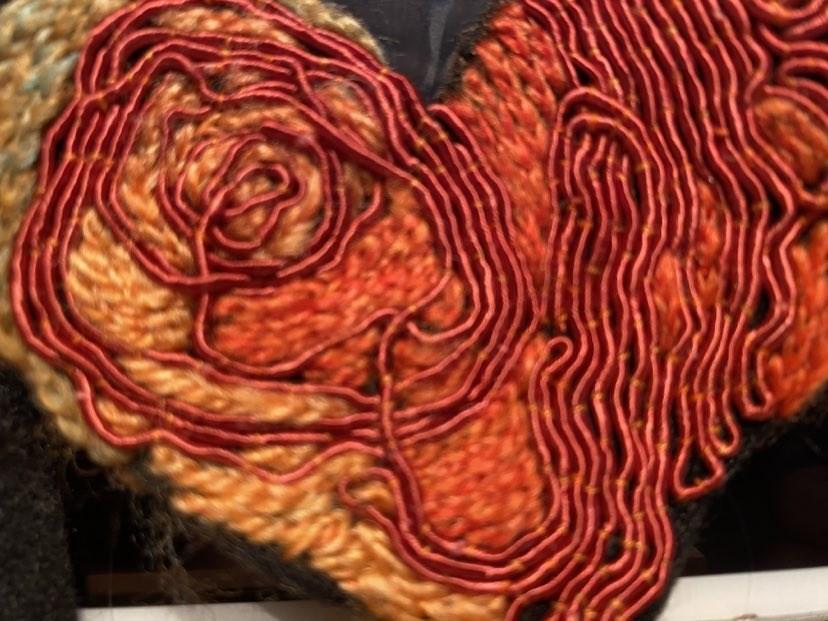
I look forward to seeing some of your sewing: thestitchboook@aol.com
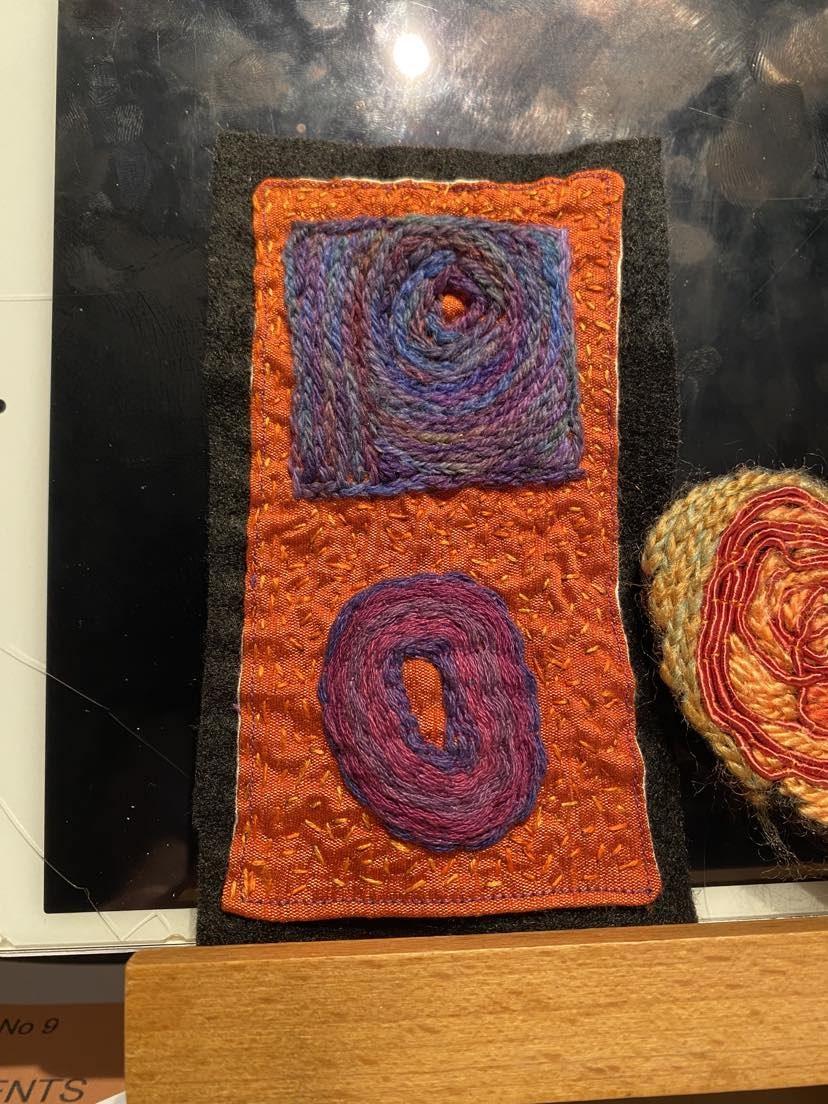
10
The Butterfly Effect I need your help ...
Get involved in the decision-making and design-process for a NEW quilt for Festival of Quilts 2024 and you could WIN a hardbacked copy of ‘The Art of Embroidered Butterflies’ by Jane E Hall.


All you have to do is to email a suggestion regarding the potential Festival of Quilts entry for 2024. EVERYONE who emails a suggestion of any kind BEFORE 27th OCTOBER 2023 will be entered into the draw.
ALL suggestions will be considered and discussed over the coming months. The only things which are already decided are:
• The title of the quilt will be ‘The Butterfly Effect’
• The quilt will include hundreds of origami butterflies made from scrap/recycled fabric by members of the Collective
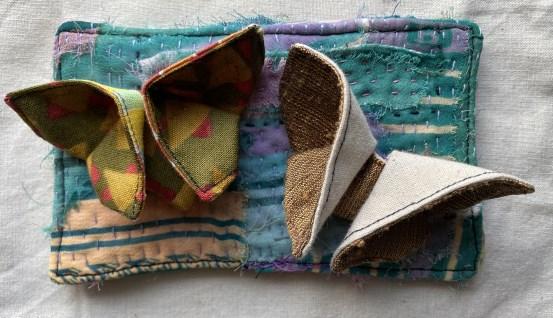


• The butterflies will be made in batches and delivered to Untangled Threads every 2 months
• e.g. January/February butterflies will be in shades of blue/ green, March/April butterflies will be in shades of red/orange etc
• The target is 5 per member over the year. This would potentially give us 1,000 butterflies but more could be amazing!
Things you might like to think about:
Suggestions for the overall design and size of the quilt?
Which category do you think we should enter?
Does the quilt need to be flat, or wall mounted? .. have a look at this year’s categories and winners for ideas..
Could we incorporate the idea of Stitchbooks into the design?
Can you make any suggestions about how to involve more members in making the quilt itself (not just the butterflies).?
Give it some thought, and email me before 27th October with some ideas! Winner of the draw will be announced in Issue 11 of the magazine.
GET PRACTISING! on the next page there are full instructions on how to make the butterflies (and there is a BONUS video on the website)
11
The Butterfly Effect
You need 2 pieces of fabric measuring 4” x 3”
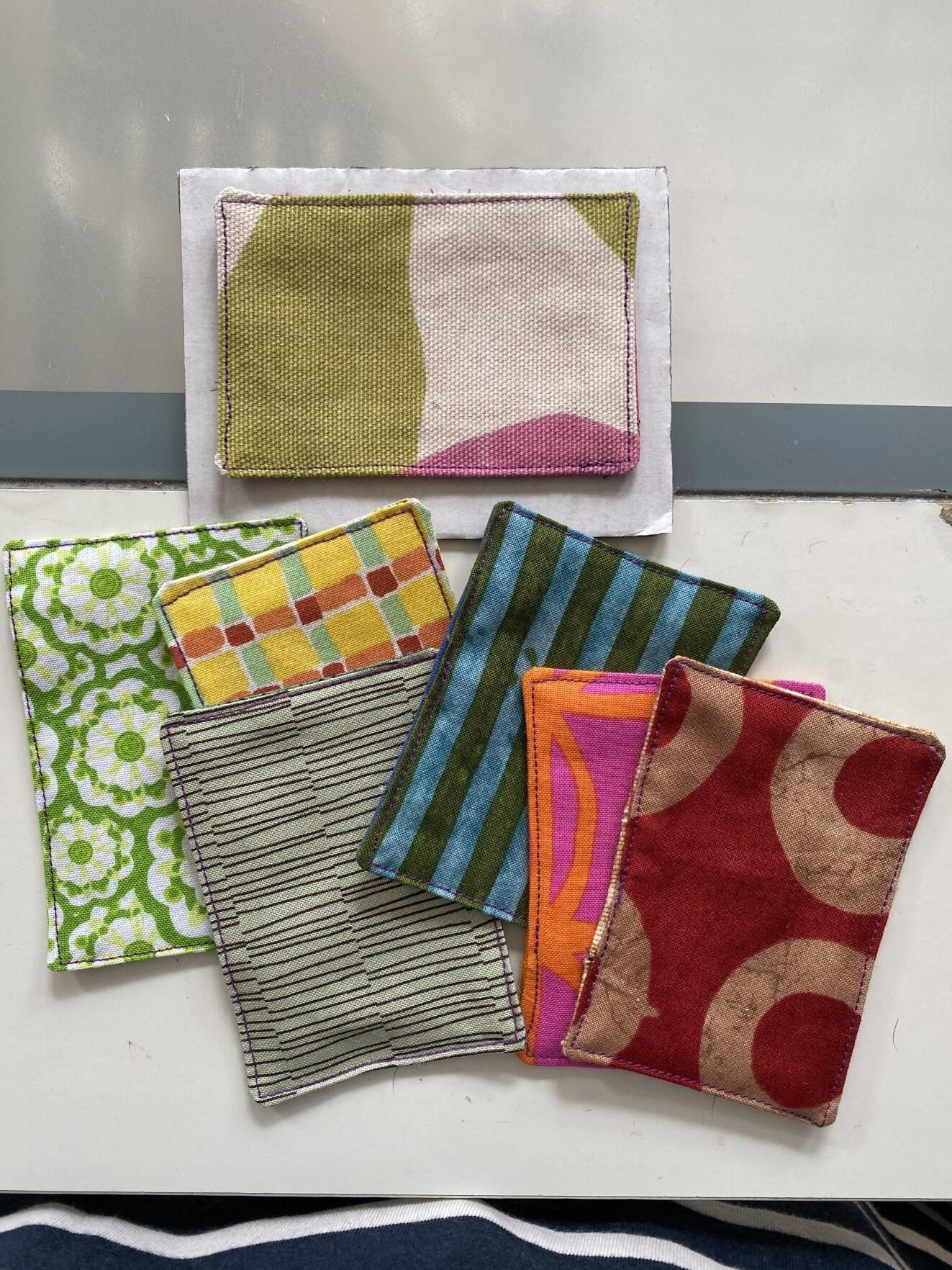

With right sides together, stitch all the way round, leaving a gap, with 1/2” seam allowance. Clip the corners and turn out.
Iron well. Top stitch right the way round as close to the edge as possible
Folding the butterfly is much clearer to show on the video
www.thestitchbookcollective.com
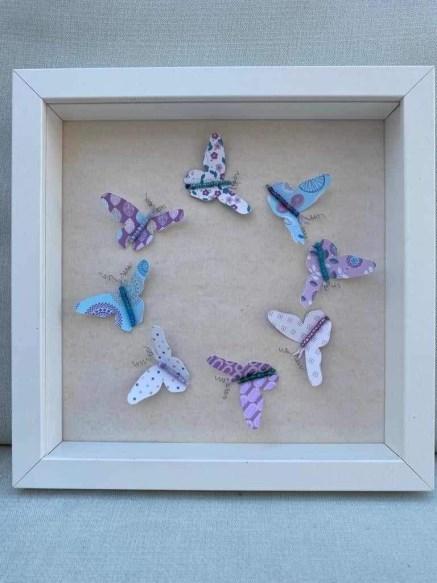


12
Inspired by Origami Butterflies by Phillipa Griffiths
NEW MONTHLY FEATURE
“You have to focus on the people in your life who bring you back home to yourself. You have to focus on standing up for that kind of connection, on honoring that calm, because it exists. It exists. And I hope you learn to trust that, because when you come across it, when you ultimately experience it, it feels as if you are standing at a door you finally have the keys for. You enter it with ease. There is no fumbling through your jacket pocket trying to find the right way in. There is no desperately reaching into your bag trying to uncover the point of access. You are no longer banging your fists against the door, asking to be invited in. You walk through. Soundlessly. Softly. Relief washes over you. You take off your shoes. You hang your coat in the closet. You put on a pot of coffee. You’re home. You’re home.”
- Bianca Sparacino
Stitching Myself Back Together
by Emma Freeman
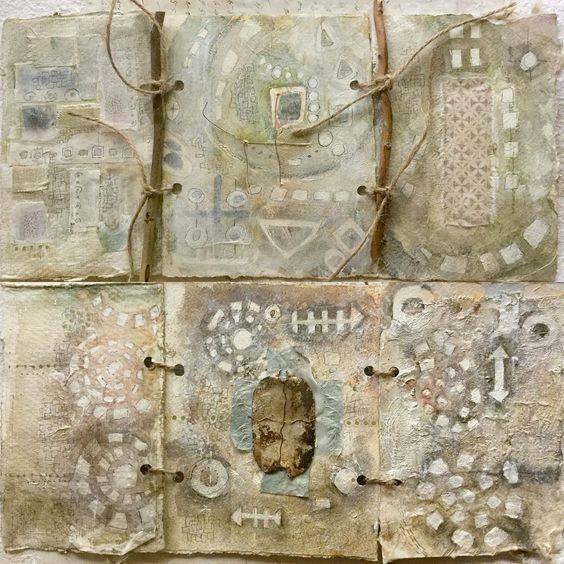
I started to unravel somewhere back there My edges began to fray and the structure that held me together began to fall apart I found myself sitting there looking at a worn out pile of fragments that once fit together in a particular way A puzzle who’s pieces had warped too much to ever fit back together in the same way As I watched them they began to whisper to me ask me new questions about what they could be what they could mean what kind of structure they might become what story they might tell My hands began to move Slowly so slowly building something that was not yet clear the first steps on a long journey the map for which I would receive once I reached a place much further down the road.
https://notrealart.com/fiber-artist-emma-freeman-meditative-practice/



13
MELINDA COOTSONA
EMMA FREEMAN
ROXANNE EVANS STOUT
Hearts & MIND -
So far this project has been a HUGE success. I made a total of 600 kits to be distributed to members and then to be sold via the online shop on www.untnagledthreads.co.uk
As of 04/09 there are only 17 kits left in the shop! £1.00 from each kit is being donated to MIND, so that already £583.00 has been raised from this project.
Each time a heart is decorated and returned to me, it is acknowledge by email, photographed, catalogued, and hung onto the Celebration Tree. The sender’s name is added into the Prize Draw, as an extra thank you.
Thank you so much for taking the time to make and return a heart for The Untangled Threads' Celebration Tree. Your heart has arrived safely, and has been catalogued and included as part of the MIND Fundraising Project.
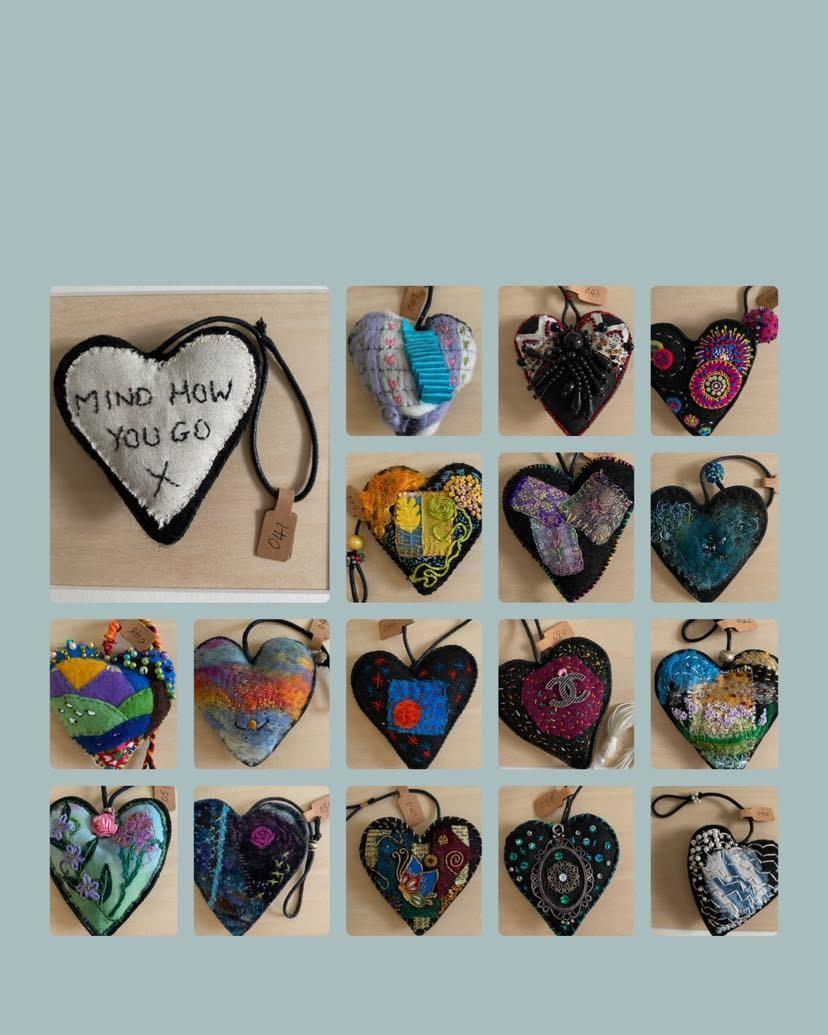
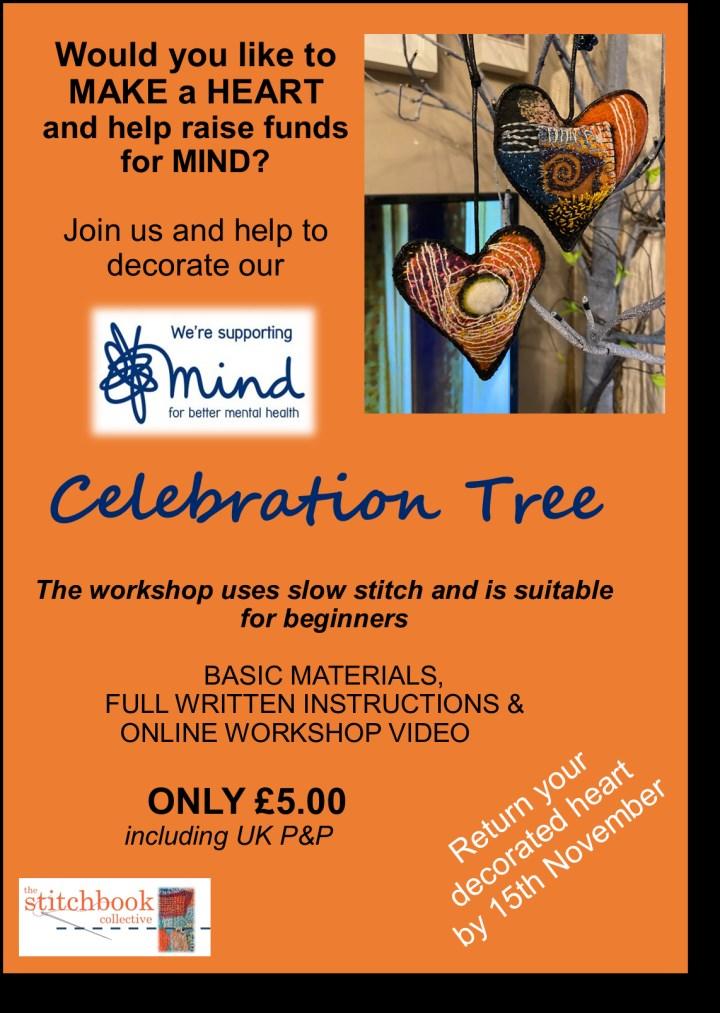
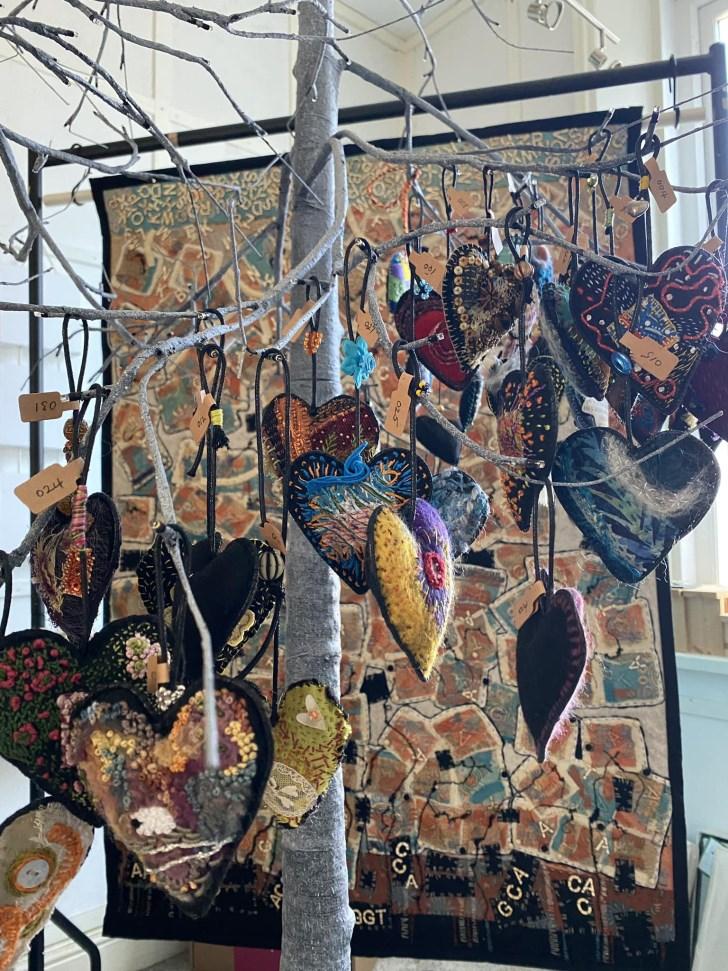
Your heart is No: XXX
All of the hearts will be offered for sale on the website www.untangledthreads.co.uk from 20th November 2023. All proceeds will be donated to the mental health charity MIND.

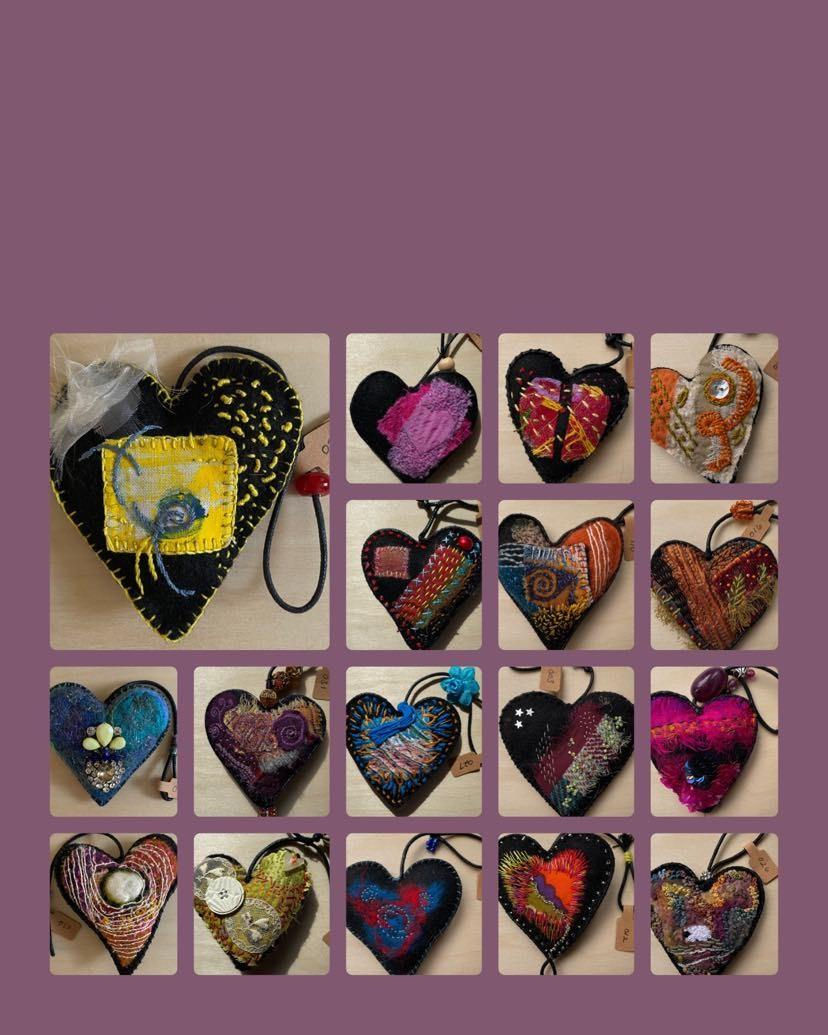
As an extra 'Thank you', your name has been added to the PRIZE DRAW which will take place on 16th November 2023. The winner will be notified by email.
Your participation in this project is really appreciated. My heart swells with pride to be part of such a wonderful, generous group of people.
So far 51 hearts have been returned.
MAKE SURE YOU RETURN YOUR HEART by 15th November 2023 for guaranteed inclusion in the online SALE and CATALOGUE
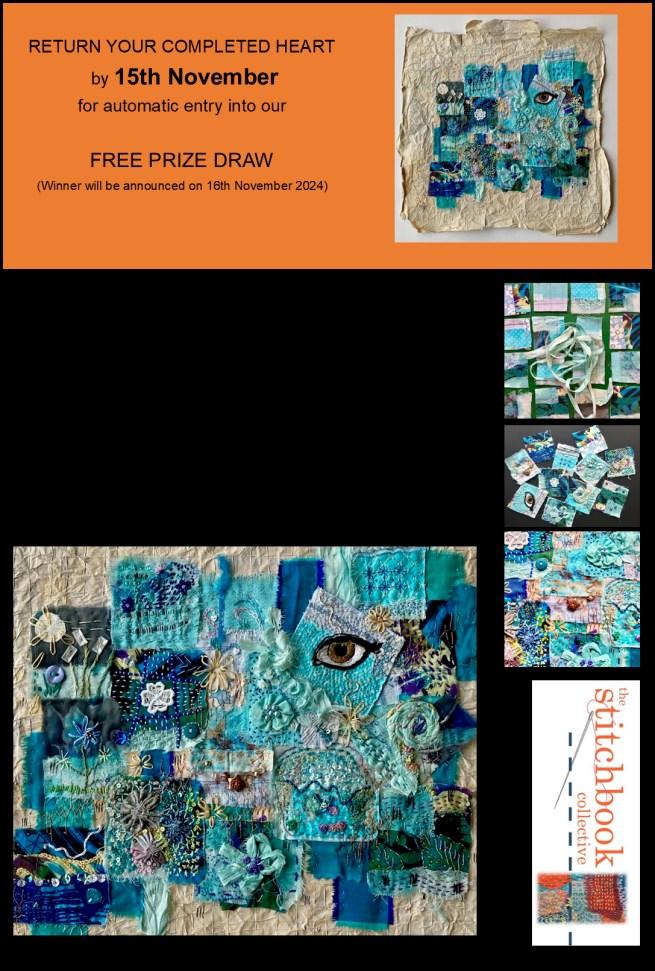
14
PROJECT
UPDATE
It does seem like an awfully long time since we last talked about the DNA spiral, but your input hasn't been forgotten, and the artwork is finally going to be shown in a large gallery space in Scarborough.

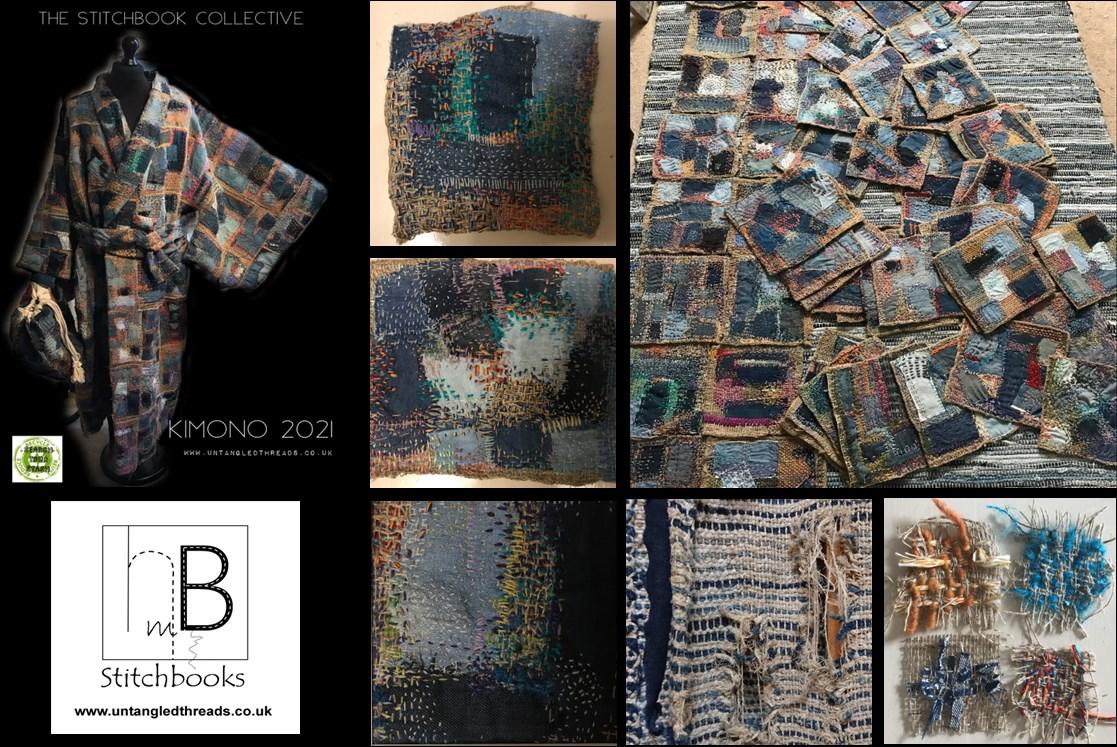



I know that this isn’t the best venue for members of The Collective to get to, but it would be great to see you. Let me know if you intend coming and I’ll make sure that I’m there (it’s only over the road from my place!)
What I am hoping for though, is that this will be a great opportunity to photograph the 20m long soft sculpture in situ, and to then be able to use those photos to promote us, and our collaborative work to a wider audience. (I’m still hopeful for a Gallery Space at K&S in Harrogate one year!)
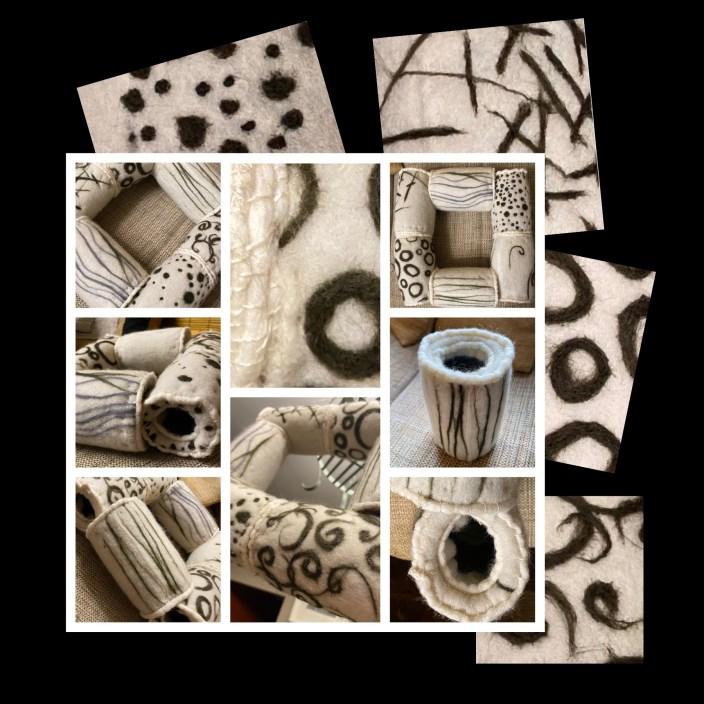
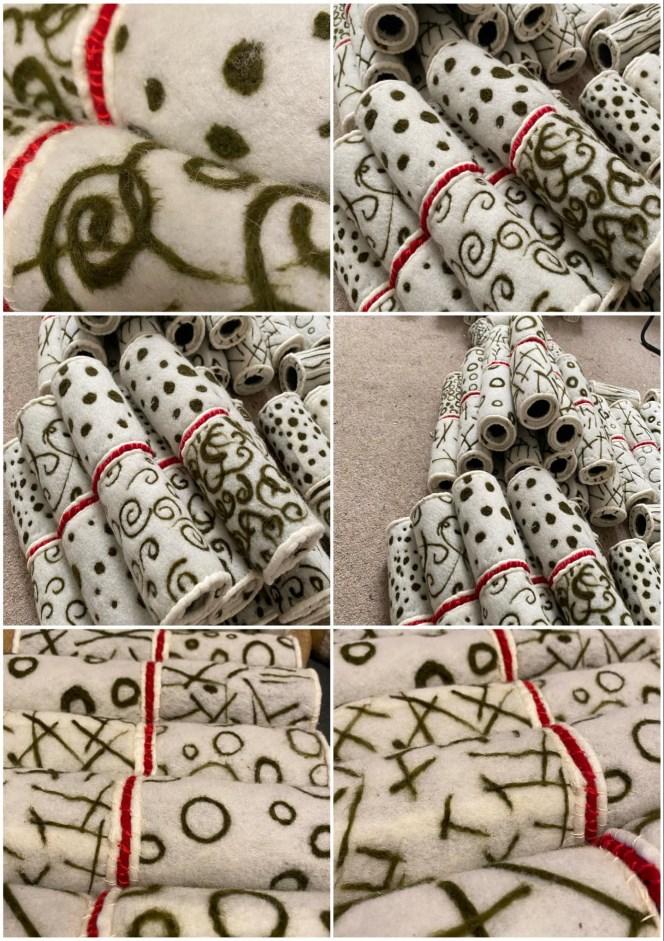

I’m not certain yet, but I think that Primordial Soup and The Kimono will also be on display at this exhibition.


I’ll let you know as soon as I have more information.

15 Rob Moore & Friends Old Parcels Office Railway Station Car Park Westborough Scarborough YO11 1TU info@oldparcelsoffice.org Private View Saturday 21st October from 2.00pm - 4.00pm Open 26, 27, 28, 29 October 2, 3, 4, 5 November Thursday, Friday Sat and Sun 11.00am - 4.00pm
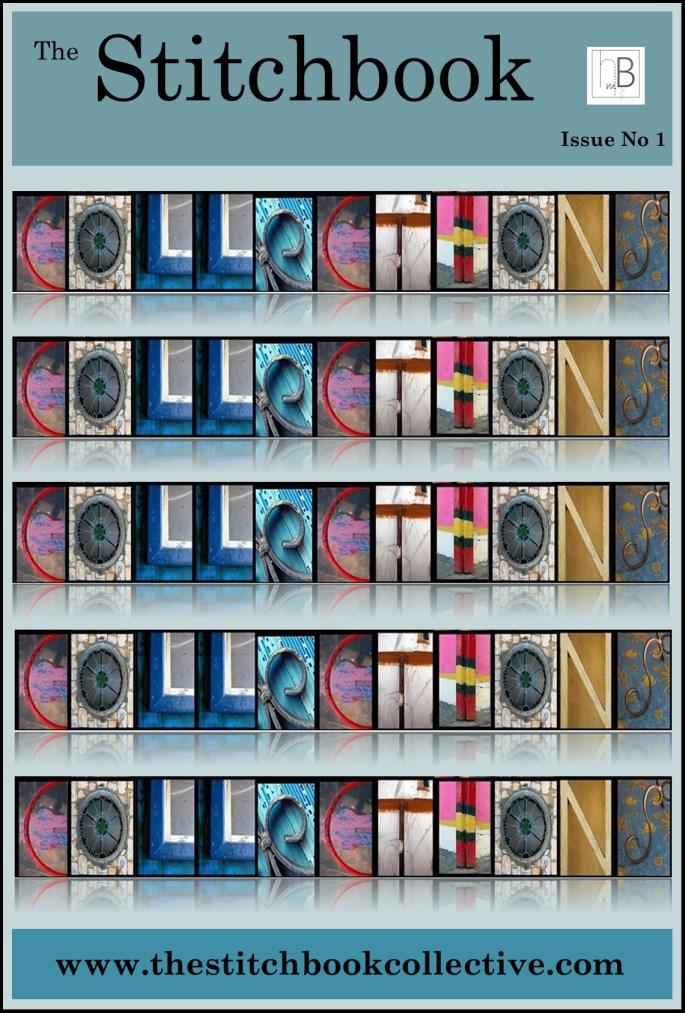
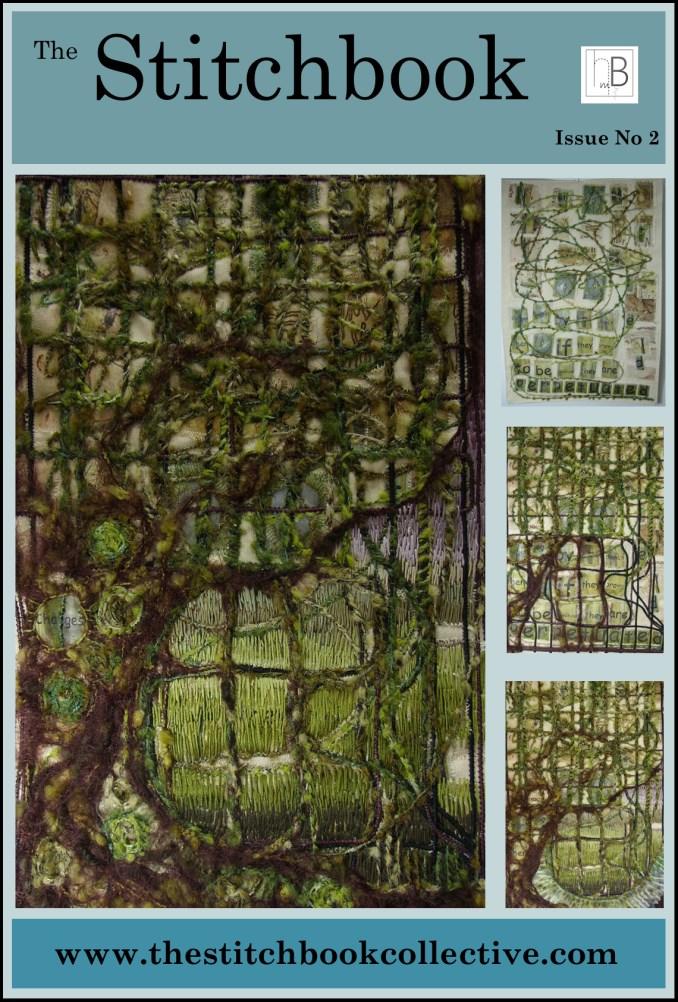

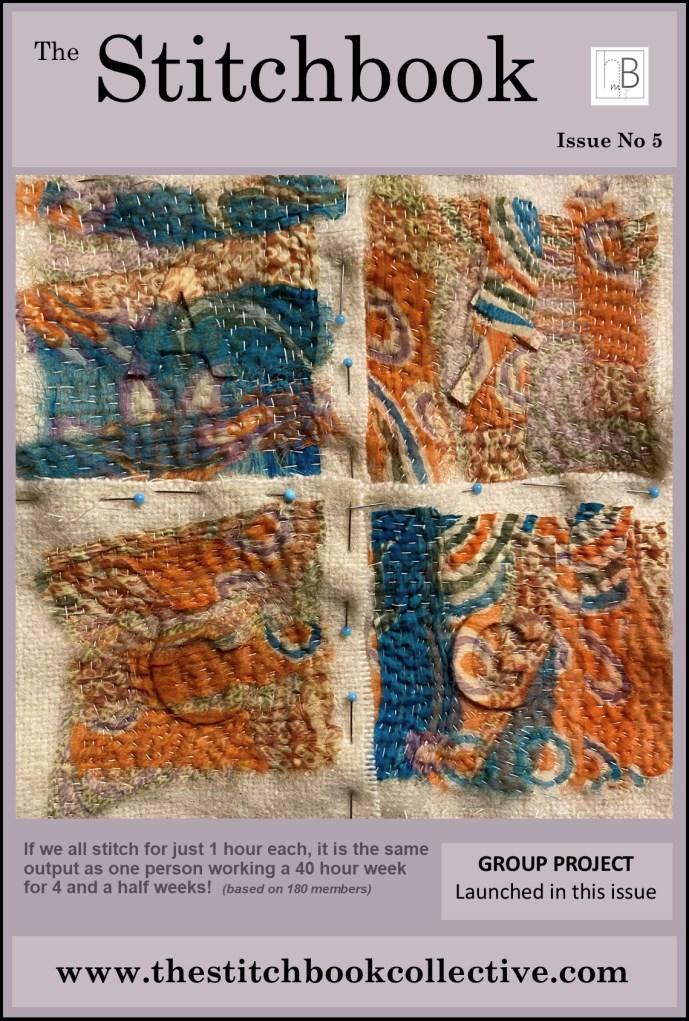
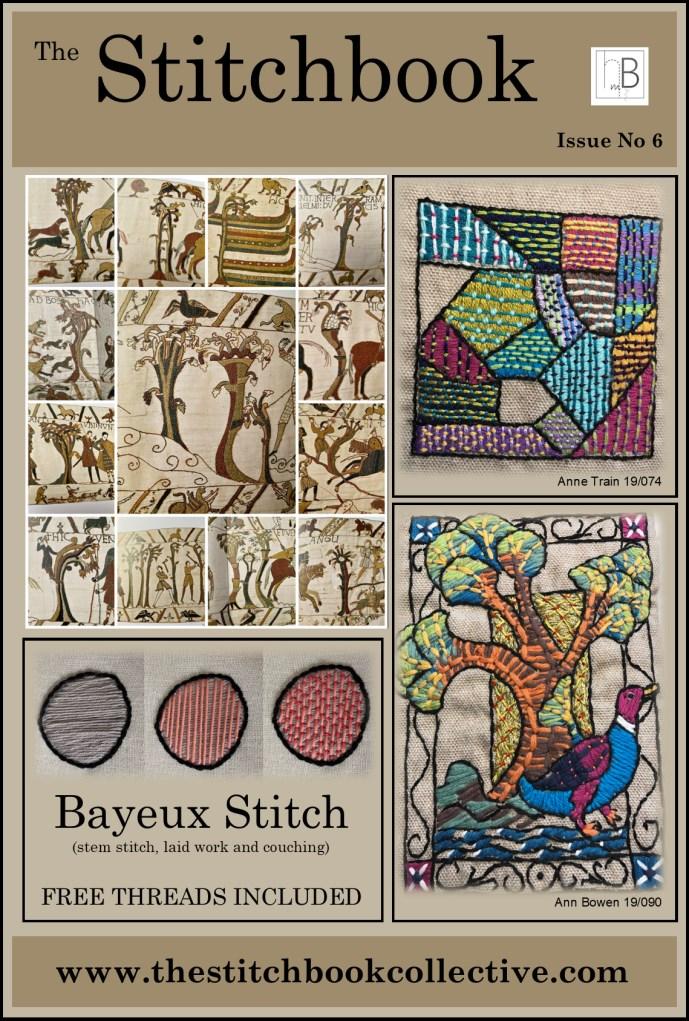
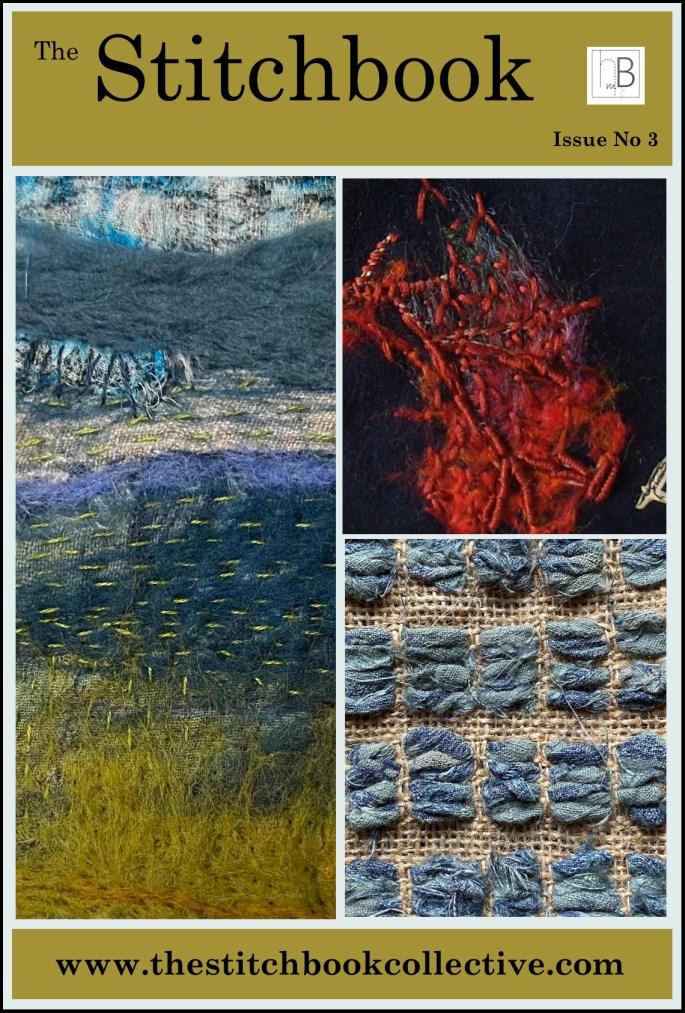
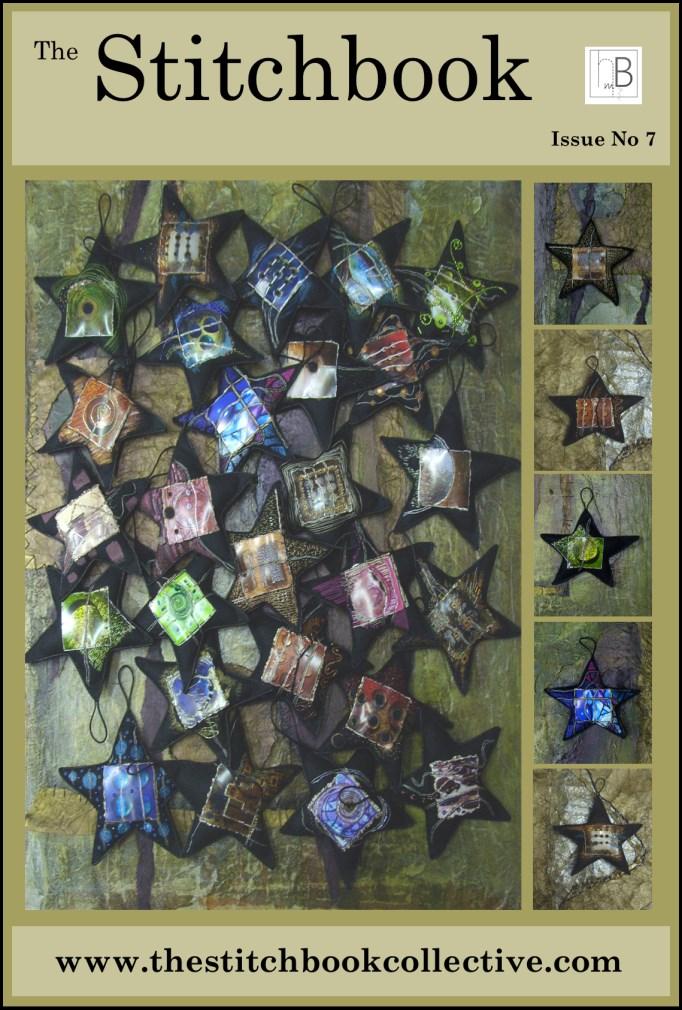

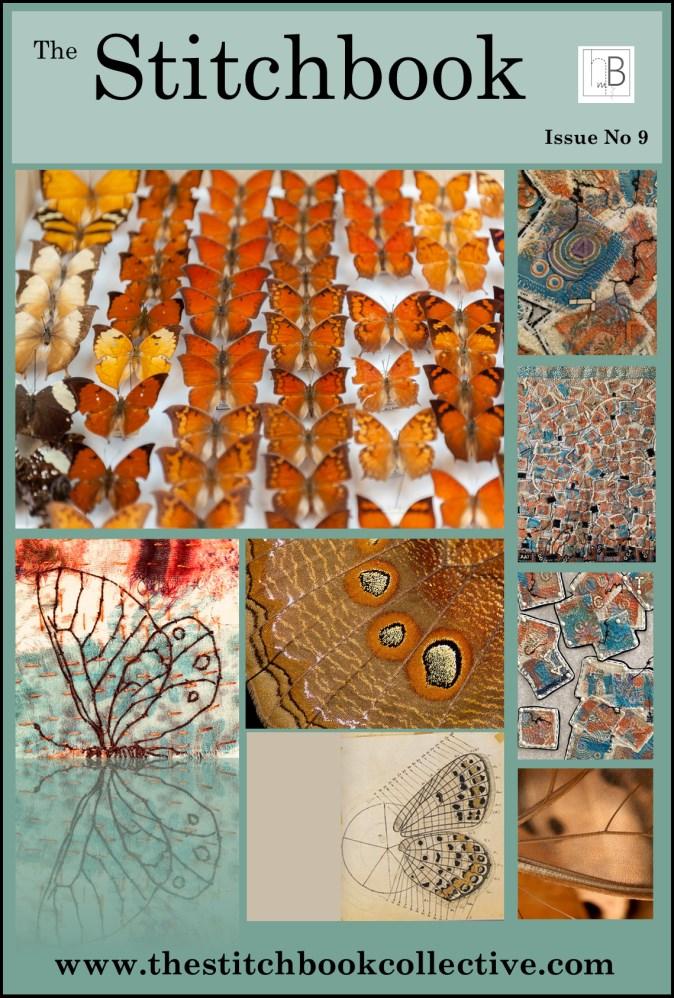
16
BACK COPIES OF MAGAZINE (for members ONLY)
If you have been a member of The Stitchbook Collective since we launched the FIRST ISSUE of The Stitchbook Magazine you will already be the proud owner of a full collection . However, if you joined the group after January 2023 you may want to complete your collection of printed copies.
MEMBERS ONLY can purchase back copies by sending a request by email to: thestitchbook@aol.com
I will let you know if copies of a particular issue are still available and send you an invoice via email for direct payment by BACS. The back copies can be purchased for £5.00 each, which includes 2nd class Royal Mail postage.
This offer is NOT available to NON-MEMBERS
INFORMATION FOR GROUP LEADERS
As you know, my aim is to reach people who have a shared interest in hand-stitching for good mental health, and one way to do that, in an economically viable way for groups, is, as you say, for the tutor to enrol as a member, and then share the learning and inspiration with others. You will also be aware that a part of each subscription is donated to the mental health charity MIND. So with that in mind, my offer to group leaders is:
a) The Group Leader takes out a 12 month membership (for Group Leaders this needs to be paid in full £114.00) and includes £12 donation to MIND
b) The Group Leader then has 12 months access to the members ONLY website http://www.thestitchbookcollective.com
The website includes a new workshop video each month, with full pdf instructions, both of which can be downloaded via VIMEO;
The website will also give you access to the workshop archive (techniques and inspiration); Access to previous monthly workshop videos; Access to PDF's of previous monthly magazines since January 2023. (see http:// www.untangledthreads.co.uk for full details of membership.)
c) The Group Leader will be added to the membership list, and will be sent a paper version of the next 12 issues of the magazine. This is sent via Royal Mail before 2nd Monday of each month.
d) As a new member, the Group Leader will also receive a copy of the publication called 'the stitchbook collective: a shared vision'. This is a fully illustrated introduction to the Untangled Threads Stitchbook, its history and full instructions for making your own stitchbook. Group Leaders can order up to 10 copies of this publication FREE with their annual membership subscription.
The Group Leader MUST NOT share access to the members only website with their group. The intention is that the Group Leader engages with the website and the rest of our 200+ members, and then PRESENTS their own workshops to their own group, in their own style. HOWEVER, to assist in your teaching, additional copies of printed magazines CAN be ordered (only by the Group Leader) and can be delivered (to the Group Leader's address) for an additional £5.00 per copy (Payable by BACS).
So, for example, if you have a class of 6 who would each like their own copy of a particular magazine, you can order an extra 6 copies (for £30.00) which will be delivered along with your own monthly magazine.
17
Samaritans. To talk about anything that is upsetting you, you can contact Samaritans 24 hours a day, 365 days a year. You can call 116 123 (free from any phone), email jo@samaritans.org or visit some branches in person. You can also call the Samaritans Welsh Language Line on 0808 164 0123 (7pm–11pm every day).
SANEline. If you're experiencing a mental health problem or supporting someone else, you can call SANEline on 0300 304 7000 (4.30pm–10.30pm every day).
National Suicide Prevention Helpline UK. Offers a supportive listening service to anyone with thoughts of suicide. You can call the National Suicide Prevention Helpline UKon 0800 689 5652 (6pm to midnight every day).

Campaign Against Living Miserably (CALM). You can call the CALM on 0800 58 58 58 (5pm–midnight every day) if you are struggling and need to talk. Or if you prefer not to speak on the phone, you could try the CALM webchat service. Shout. If you would prefer not to talk but want some mental health support, you could text SHOUT to 85258. Shout offers a confidential 24/7 text service providing support if you are in crisis and need immediate help.

The Mix. If you're under 25, you can call The Mix on 0808 808 4994 (3pm–midnight every day), request support by email using this form on The Mix website or use their crisis text messenger service.
Papyrus HOPELINEUK. If you're under 35 and struggling with suicidal feelings, or concerned about a young person who might be struggling, you can call Papyrus HOPELINEUK on 0800 068 4141 (24 hours, 7 days a week), email pat@papyrus-uk.org or text 07786 209 697.

Nightline. If you're a student, you can look on the Nightline website to see if your university or college offers a night-time listening service. Nightline phone operators are all students too. Switchboard. If you identify as gay, lesbian, bisexual or transgender, you can call Switchboard on 0300 330 0630 (10am –10pm every day), email chris@switchboard.lgbt or use their webchat service. Phone operators all identify as LGBT+. C.A.L.L.
If you live in Wales, you can call the Community Advice and Listening Line (C.A.L.L.) on 0800 132 737 (open 24/7) or you can text 'help' followed by a question to 81066. Helplines Partnership. For more options, visit the Helplines Partnership website for a directory of UK helplines. Mind's Infoline can also help you find services that can support you. If you're outside the UK, the Befrienders Worldwide website has a tool to search by country for emotional support helplines around the world.
18
World Mental Health Day is a day to raise awareness of mental health problems. To share information about the support available. And to reach out to people who might be struggling. If we all work together, World Mental Health Day can change, and even save, lives.
https://www.mind.org.uk/
MEMBERS PAGES
Please feel free to send ARTICLES for the magazine
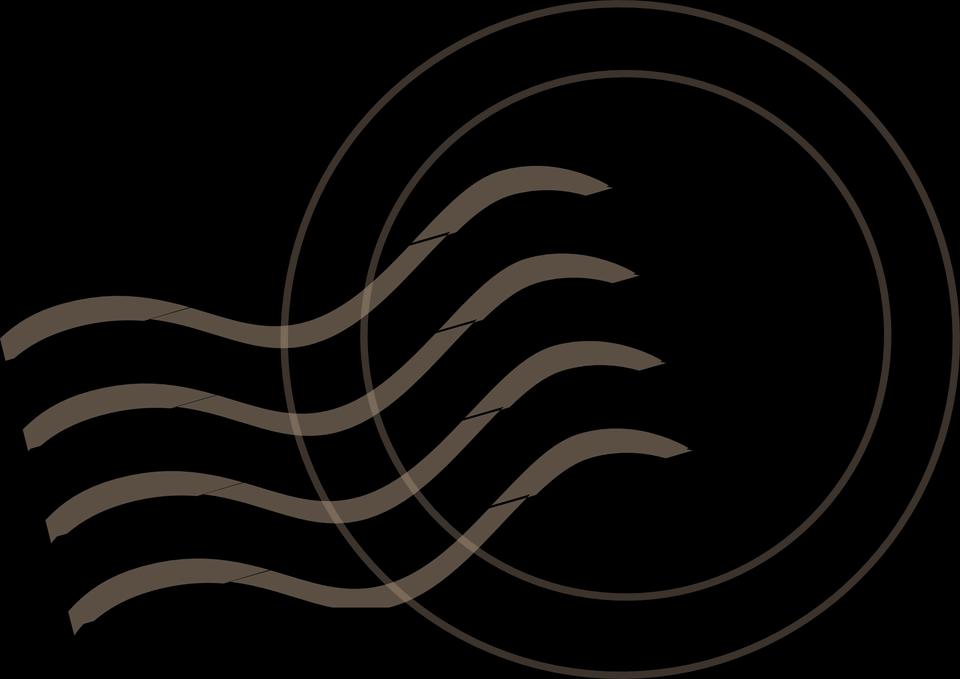
PLEASE DON’T BE SHY!!!!
Exhibition reviews, comments, opinions, obsessions etc will all be considered for publishing. I will do all of the formatting and layout. You just need to send words and pictures!
I hope that this will broaden our horizons into looking at some of the associated art/textile activities which our members undertake in addition to the Stitchbook workshops. I also hope that it will give us the opportunity to express ourselves and to offer feedback and discussion about the work of others in the collective. Between us, we have a huge pool of knowledge, information and opinion. Let’s share it!
You don’t need to be asked ….. please email articles for consideration to :
thestitchbook@aol.com
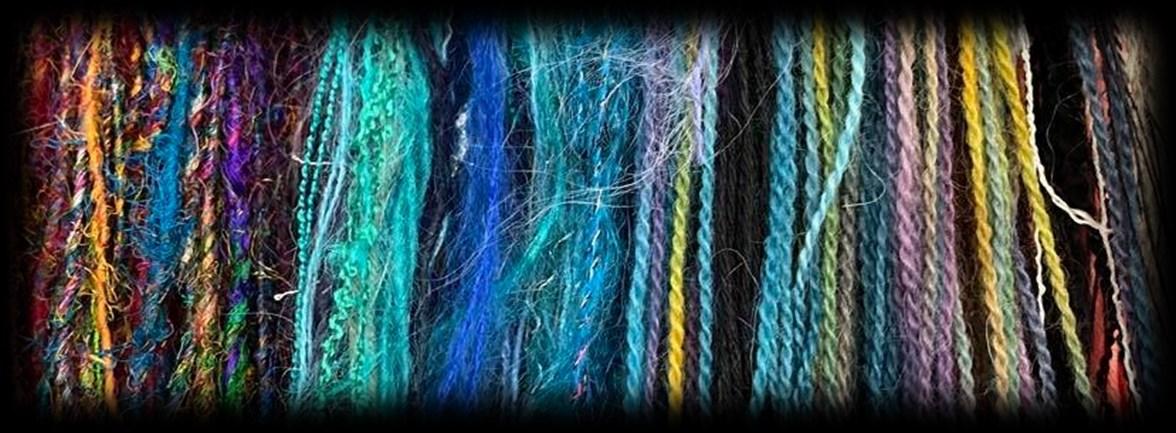

or by post to:
Helen Birmingham
5 Belle Vue Parade
Scarborough
North Yorkshire YO11 1SU
Star Letter this Month:
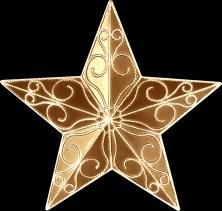
To Helen,
Please find my heart made with love. I took the kit away to France, and was surrounded by the most beautiful garden.

Thank you for all the opportunities you have given me!

19
There was the most amazing smell of lavender, so this is what I did.
A Visit to the Japanese Aesthetics of Recycling Exhibition
by Ruth Lozano
I bought my husband a kin-tsugi kit for his birthday. It came complete with a small dish that he was supposed to break deliberately to repair with gold resin. However, he cannot bring himself to break the dish. About a month ago my granddaughter grabbed a bowl from the cupboard and it smashed to the floor. I quickly scooped up the pieces of the bowl and put them straight in the bin. Only much later did it occur to me that I could have asked my husband to use his kit to repair the bowl. I was reminded of this when reading one of the information plaques at the exhibition which stated that the Japanese feel a sense of regret when something is wasted and its value is not fully realised. The exhibition showed the extent of this belief in that objects and cloth were reused, repurposed and visibly repaired.
scuffs, tears, darns and repairs. It was also clear that use had been made of any pieces of cloth that was available. Patches, whilst mainly indigo blue, were roughly cut or torn sometimes in strange shapes. The stitching on these pieces is large, often wonky and utilitarian. I assume that the maker needed the object and was stitching as fast as they could. I felt humbled as I looked on these pieces, thinking of the maker wanting to provide some comfort to their family. The display shows to craft of the poorest people which is now revered. In fact some pieces are so precious that they were displayed behind glass.

The exhibition- Japanese Aesthetics of Recycling is currently at the Brunei Gallery in SOAS at the University of London. The exhibition show cases the collection of Karun Thakar- about 100 objects highlighting the beauty of Japanese recycling. The objects mainly date from the Edo period and include examples of Boro and other textiles, washi paper and visibly repaired ceramics (Kin-tsugi). I visited the exhibition on one of the rare sunny days this year and was not disappointed. The gallery space was an oasis of calm in an otherwise crowded day in mid summer London.
There are many examples of Boro textiles on display -mainly rectangular bedding pieces and kimonoes. The thin mattresses were rolled up during the day. Their use and reuse was evident, there were holes,
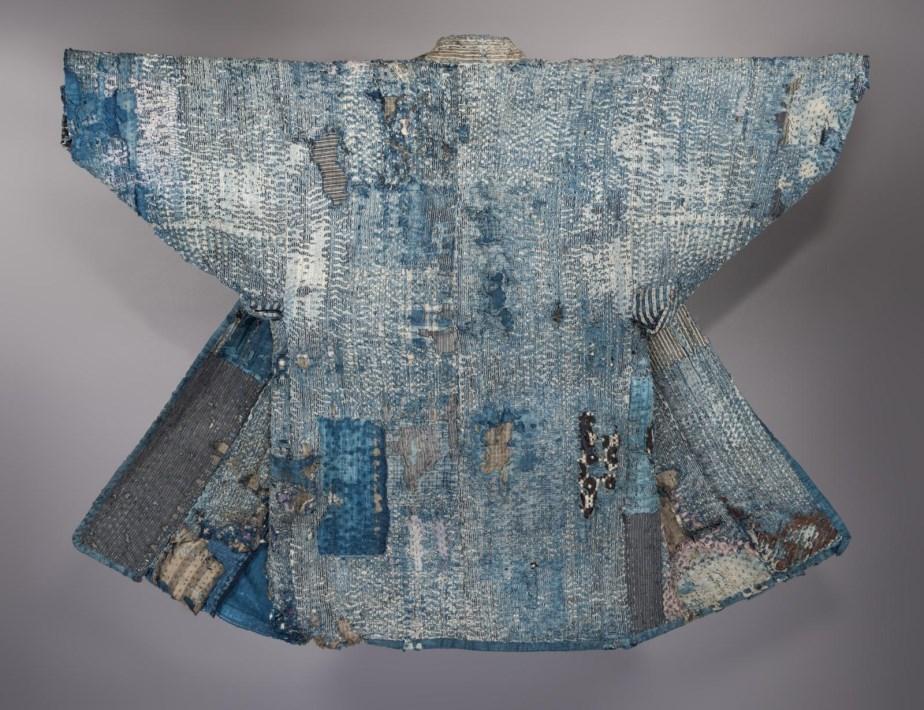
A mainly beige piece, a mosquito net, showed signs of mending using fragments of paler and coloured cloth. It now looks like an abstract painting. Many of the pieces can now be viewed as abstract works of art.
As such these pieces reveal the hands of the makers. Their lives and stories are shown in the fragments of cloth and in the drive of the maker to produce something that mattered; for care, use, love comfort and protection.
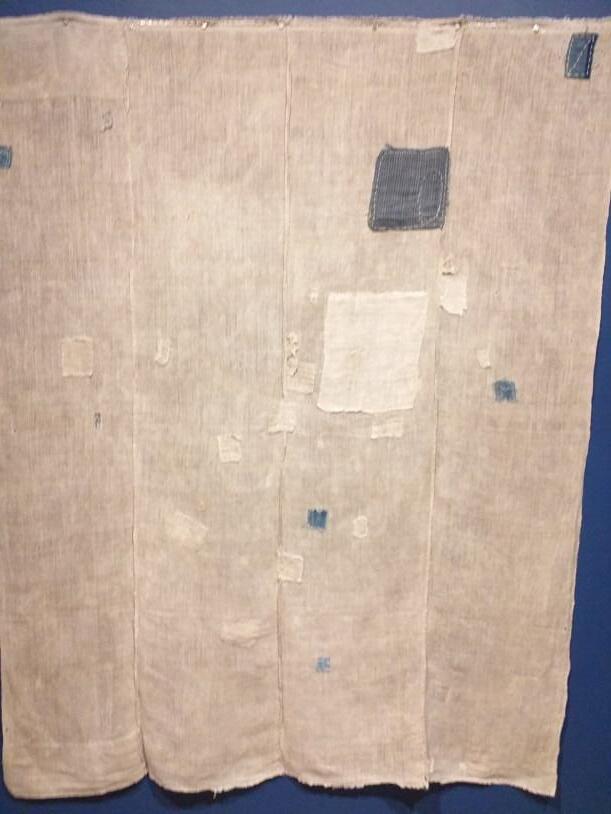
20
Ghosts of other crafts and more wealthy lives could be seen. For example some of the patches showed examples of rice resist dyeing and expensive weaving techniques. Where had the maker got these pieces of cloth? Had they been discarded or donated to the maker? There were foot coverings which were heavily patched darned and repaired revealing miles walked and journeys made. The washi papers on displayed also gave hints as to their previous lives- fragments of old documents, lists and even a rudimentary spread sheet could be detected.
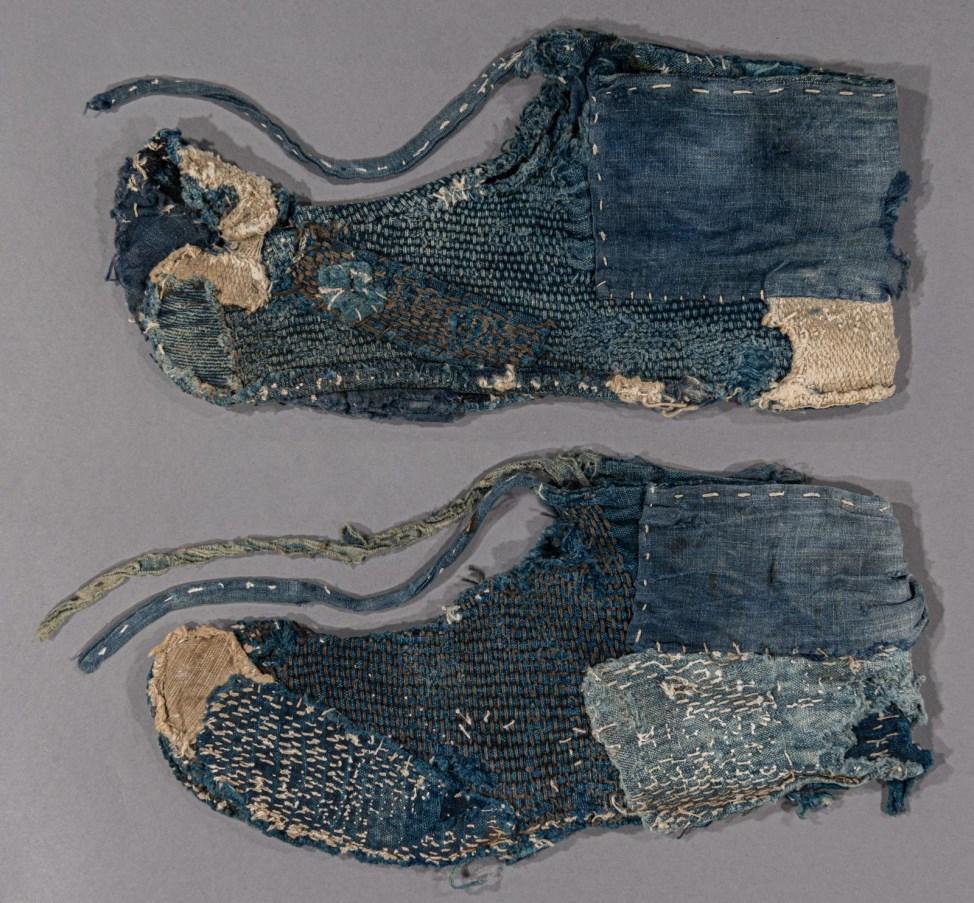
been repaired and enhanced with gold. Again I was humbled to see how the objects on display revealed not only the skills of the makers but also the history of their past.
If you go to the exhibition I encourage you to make time to experience the Japanese roof garden. We also took in an exhibition at the British Museum called – Artists Making BooksPoetry and Politics. It is a small, free exhibition exploring the history of artists making books.
https://www.soas.ac.uk/about/event/japaneseaesthetics-recycling
It was evident that fabric was extremely precious and great care was taken to make use of every tiny fragment. In a side room I saw balls of fabric strips made by tearing or shredding cloth. There were examples of how this thread had then been woven into pieces of fabric and made in to garments. Sometimes the fabric was woven together with paper that had also been made in to a fine thread. The paper had not been bleached and so tiny dots of previous printing made interesting marks on the weaving.
Of course there were examples of bowls and other ceramics that had been repaired using the Kin-tsugi method. These pieces had been beautifully made and decorated. However, they had at some point been broken. Instead of discarding the object, as I had done, it had
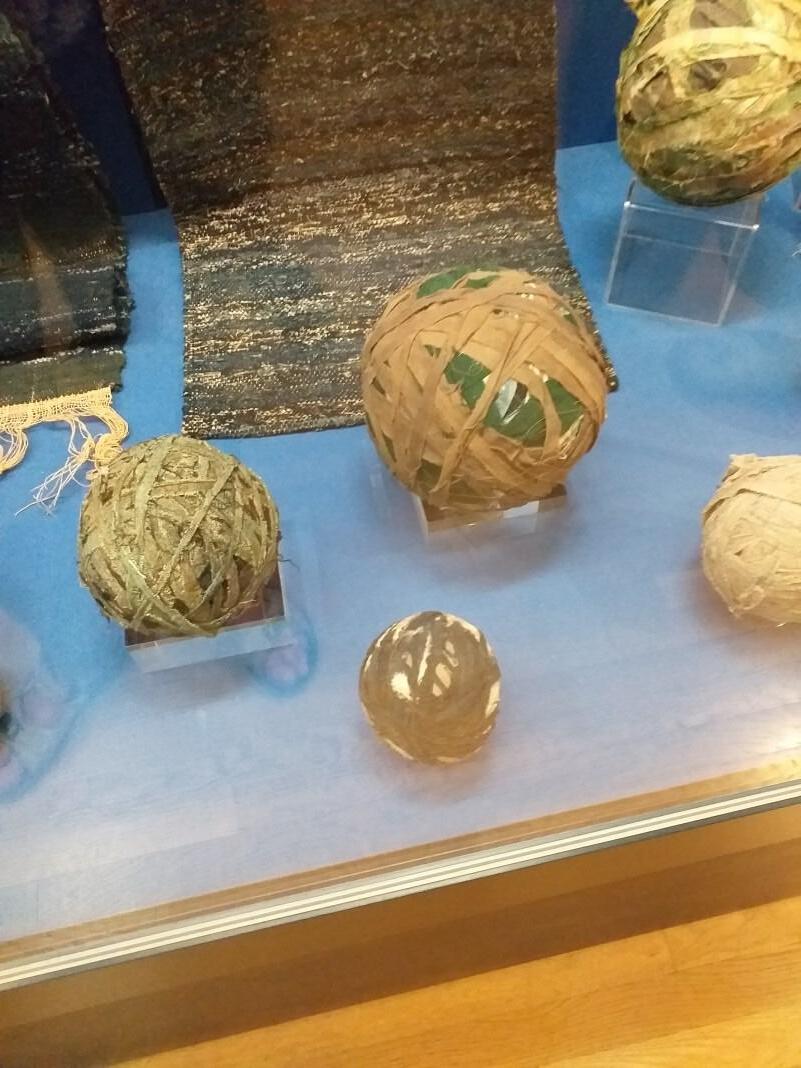
Indigo is one of the oldest plant dyes in existence. Since it made its way into Japan approximately 1400 years ago, indigo would enjoy popularity among aristocrats and commoners at various points in history.
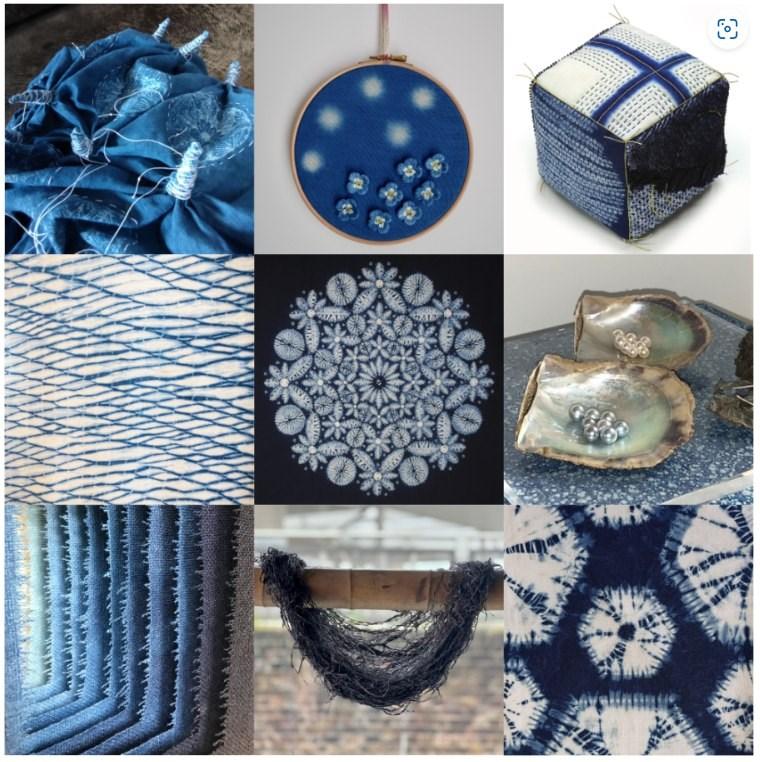
The art of aizome (indigo-dyeing) became so prevalent and the fabric colour so commonly worn that when British chemist R.W. Atkinson visited Japan in the 1870s, he labelled the colour ‘Japan Blue’.
The influence of aizome can be widely seen inside and out of Japan. This exhibition brings together highly skilled artists whose works show the respect for tradition and spirit of innovation, in a variety of materials including textiles, leather, paper and pearl.
21
posted by Helen Dickinson
This piece was in last month’s magazine as part of my article about The Festival of Quilts 2023. I am thrilled that Mary has submitted this article which expands on her entry in the Sustainable Quilts category.
My research has led me to consider exactly what we mean by sustainable. The United Nations states that sustainable development must end poverty while, at the same time, improving education and health for all, without depleting the resources of the planet. So, to be sustainable, the textiles industry must be also ethical, it is not just about ‘natural sources’ of materials. Who grew the crops? Who worked in the factories that made the fabrics? Were they paid a fair wage and working in safe conditions? It is 10 years since the Rana Plaza disaster and still many fashion workers work in dangerous conditions and are poorly paid.
I wanted to use my quilt to raise awareness of the broader issues around sustainability, and not just reuse materials, so I referenced two of the many clothing factory disasters and reminded people to think about the people who made their clothing.
‘To be sustainable, fashion industry must be also ethical. It is 10 years since the Rana Plaza disaster and still many fashion workers work in dangerous conditions and are poorly paid. This quilt supports the campaign of @labourbeindthelabel to improve the conditions and empower fashion workers.’

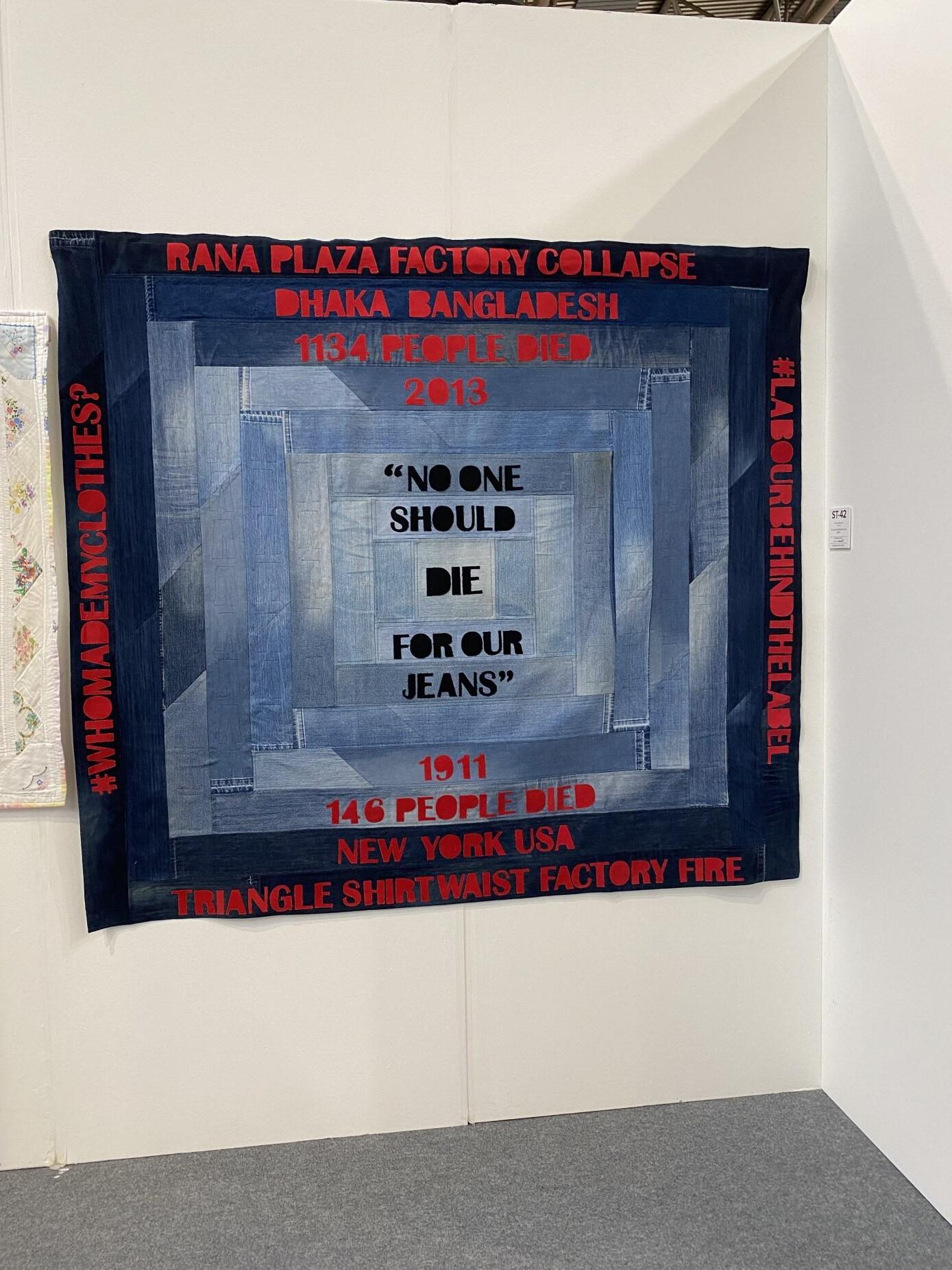
Nobody should die for our jeans
by Mary Whitehouse
The Festival of Quilts 2023 introduced a new category Sustainable Quilts in the competition. This announcement chimed with me as I have been attempting to make my practice more sustainable, and as part of my Foundation Degree in Textiles Practice at Bradford School of Art I have been researching what sustainability means for the textiles and fashion industries.
Festival of Quilts defined a sustainable quilt “as a quilt which has been made with minimal negative impact on the environment”. The focus of the description was to encourage makers to use at least 75% repurposed materials and the remaining materials to be from “sustainable and natural sources” as far as possible.
In 2022 my sustainable textiles project at Bradford was to make a coat from the factory waste from Hainsworth Mill in Stanningley, Leeds.
This coat, and my quilt, will be on display as part of Bradford School of Art's contribution to Sustainable Fashion Week 30th September - 1st October. https:// thestitchsociety.com/sustainable-fashionweek/
For more about my course at Bradford see https://www.bradfordcollege.ac.uk/courses/ fda-textiles-practice/
22
by Sarah Reed
My attempts at self portraits! The whacky one was an experiment a couple of years ago!
by Irene Baldock
IB: I’ve recently joined the group. I thought I would show you my stitched portrait inspired by Sue Stone…


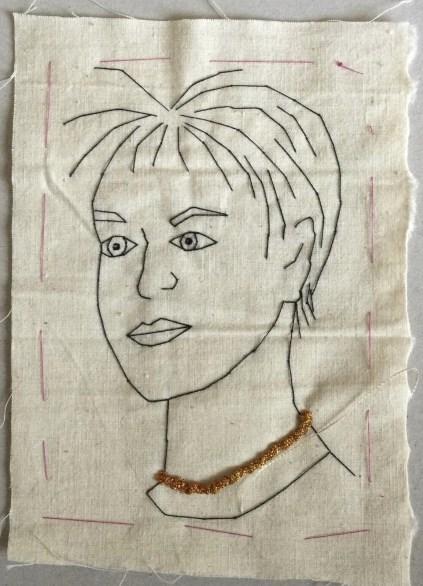
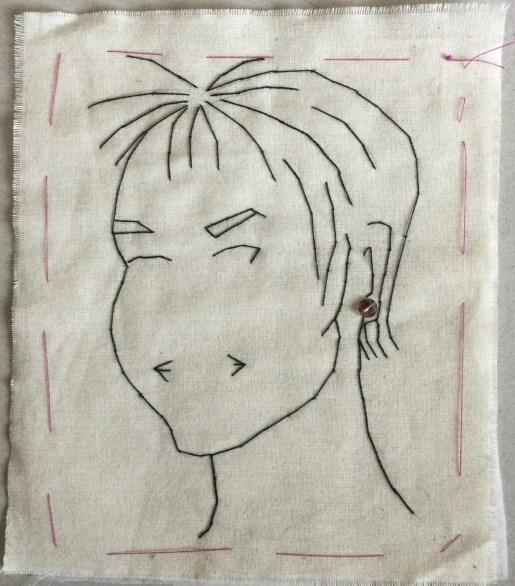

HB: Welcome to the group Irene! This is fabulous. Did you cut around the figure and appliqué it onto the grey background? Note to members … It’s important to use something like Bondaweb under the figure BEFORE cutting round it, to prevent fraying!
IB: Thank you Helen. I bondawebbed the fleshy fabric so that it was stable. I outlined around my face and shoulders from a photo on to tissue paper. I stitched the outline onto the fleshy fabric. I cut the dress from coloured fabric that I bondawebbed on to the fleshy fabric. I cut very carefully around the whole outline
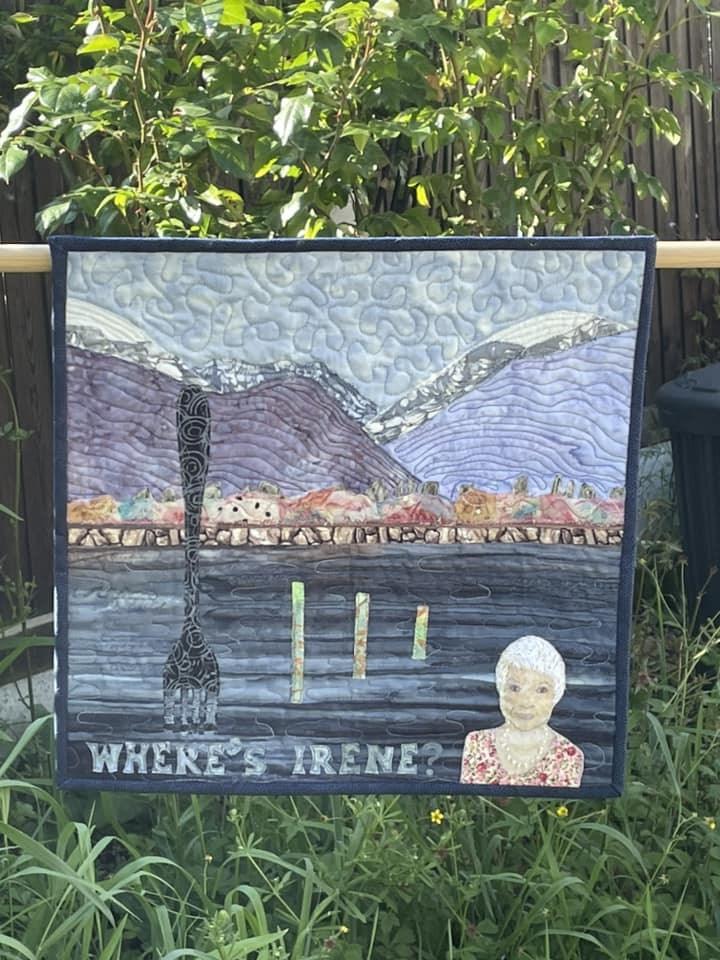
23

24 www.thestitchbookcollective.com DELIVERY ADDRESS: PAINTED AND STITCHED LANDSCAPES Issue 10: PAINTED AND STITCHED LANDSCAPES




























































































































